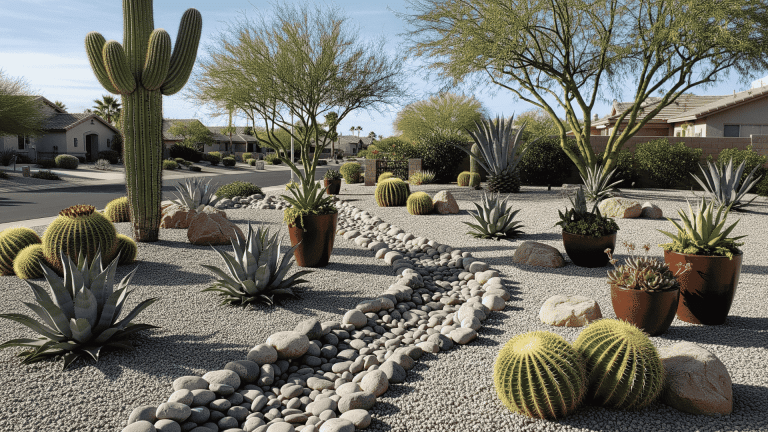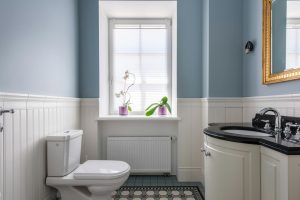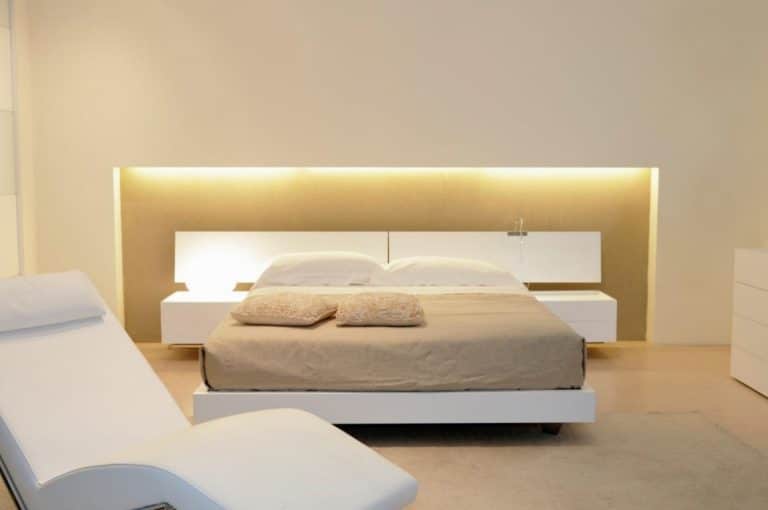I’ve always admired desert landscaping, but I didn’t want to spend a fortune to make it work for my space.
After going through various ideas, experimenting personally, and learning from others, I realized that a big budget isn’t necessary to achieve that dry, rugged beauty in your yard.
The real delight of a desert landscape comes from its minimalism and natural textures, not from pricey features.
If you’re like me and want something clean, low-maintenance, and affordable, these ideas can help you get there.
All the ideas below are focused on inexpensive desert landscaping. Most can be done with simple supplies, salvaged items, or smart arranging.
From small patios to full front yards, each idea offers a practical and affordable way to bring out the best in your outdoor space while keeping costs low.
How to Make Desert Landscaping Affordable and Stylish
Creating a stylish desert landscape without spending too much is all about working with the environment instead of against it.
Start by understanding what naturally grows in dry climates. Plants like agave, aloe, yucca, and native grasses are low-maintenance and thrive with little water.
Focus on materials that are affordable and easy to find, like gravel, rocks, salvaged wood, or concrete blocks.
These can form walkways, borders, and seating areas at relatively low cost.
Group plants in clusters and use open space as a design feature instead of trying to fill every corner.
Skip the lawn and go for drought-resistant ground covers. You can even repurpose old items like tires, cans, or pallets for planters and decor.
With thoughtful choices, your yard can be both budget-friendly and attractive.
These tips also work perfectly for anyone looking for front yard desert landscape ideas on a budget.
Inexpensive Desert Landscaping Ideas for Any Yard
Desert landscaping doesn’t have to be pricey. With some creativity and the right materials, you can design a beautiful outdoor space that’s drought-friendly and affordable.
1. Gravel Instead of Grass

Crushed gravel or decomposed granite makes a practical and budget-friendly substitute for traditional grass lawns. It fits well with desert landscaping and eliminates the need for watering or mowing.
Earth-toned gravel blends effortlessly into dry landscapes and works well for both ground cover and walkways. Over time, it helps reduce maintenance and keeps your yard tidy and functional.
It’s also easy to apply and lasts for years without needing touch-ups, making it one of the most cost-effective choices for altering a front or backyard into a desert-inspired space.
- Best for: Front yards where you want to cut maintenance completely
- Pro tip: Use landscape fabric underneath to prevent weeds
2. Use Drought-Tolerant Succulents
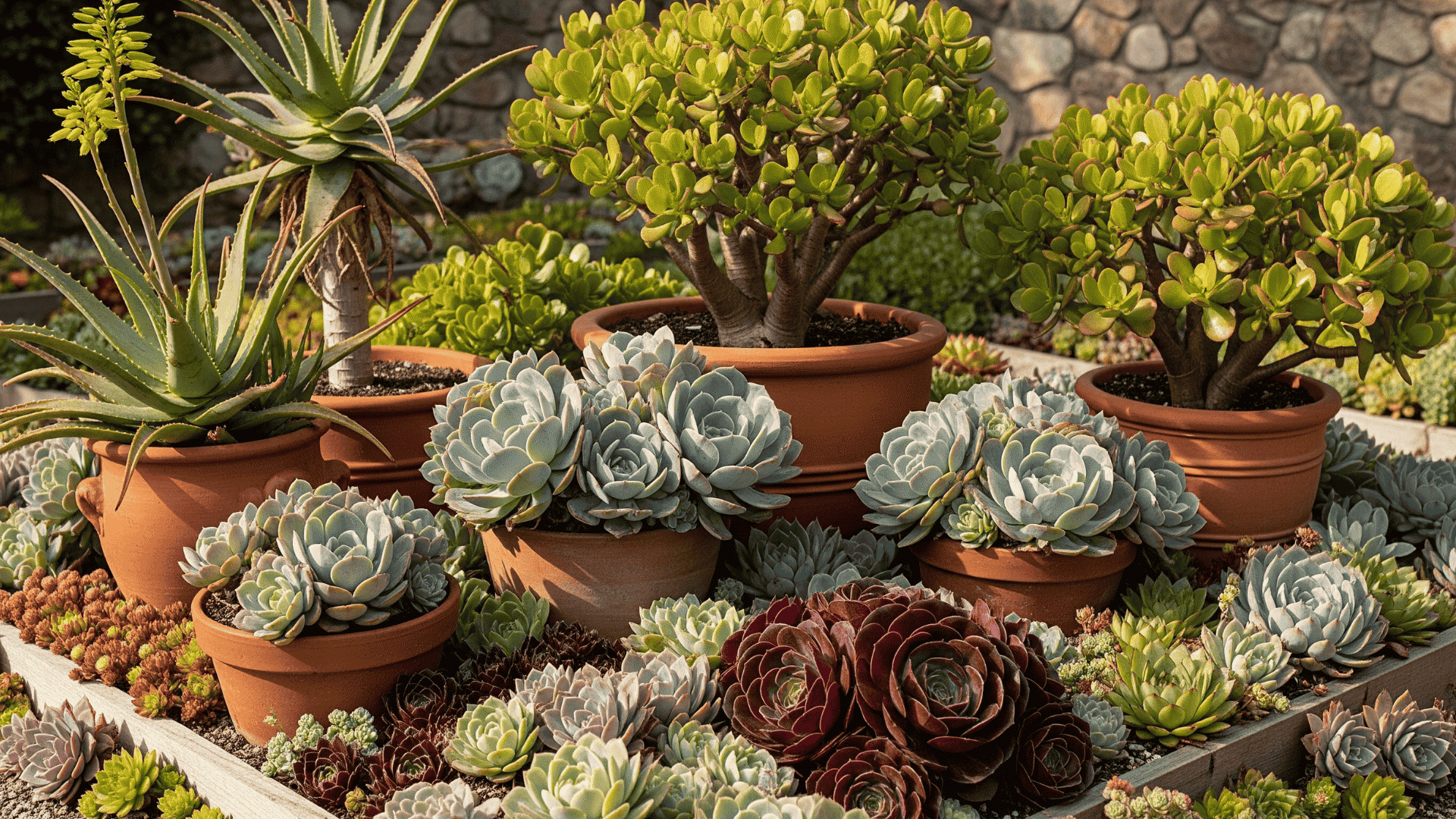
Succulents are a low-cost and water-wise option for any desert landscape. They store water in their thick leaves, making them perfect for hot, dry climates.
Many succulents, like aloe, jade, and echeveria, can be propagated from cuttings, which helps stretch your budget even further. Group them together in containers, borders, or focal planting zones to create texture and variety.
These plants offer color, structure, and durability without constant upkeep. With proper placement, succulents can thrive year-round and become a long-lasting feature in both small and large outdoor spaces.
- Best for: Containers, borders, or focal points
- Pro tip: Trade clippings with neighbors to expand variety for free
3. Build a Dry Riverbed

A dry riverbed is a visually striking and practical feature that mimics the look of a flowing stream using rocks and stones.
It’s ideal for adding movement and structure to desert landscaping without needing water. Use various stone sizes to shape a natural curve through your yard and plant drought-tolerant species along the sides.
It can help with runoff on sloped areas or simply break up flat ground with something more engaging. This project is affordable, long-lasting, and helps your space feel more attractive without any real maintenance.
- Best for: Sloped areas or spaces needing visual movement
- Pro tip: Outline it with cheap concrete edgers to keep it contained
4. Repurpose Old Bricks or Concrete
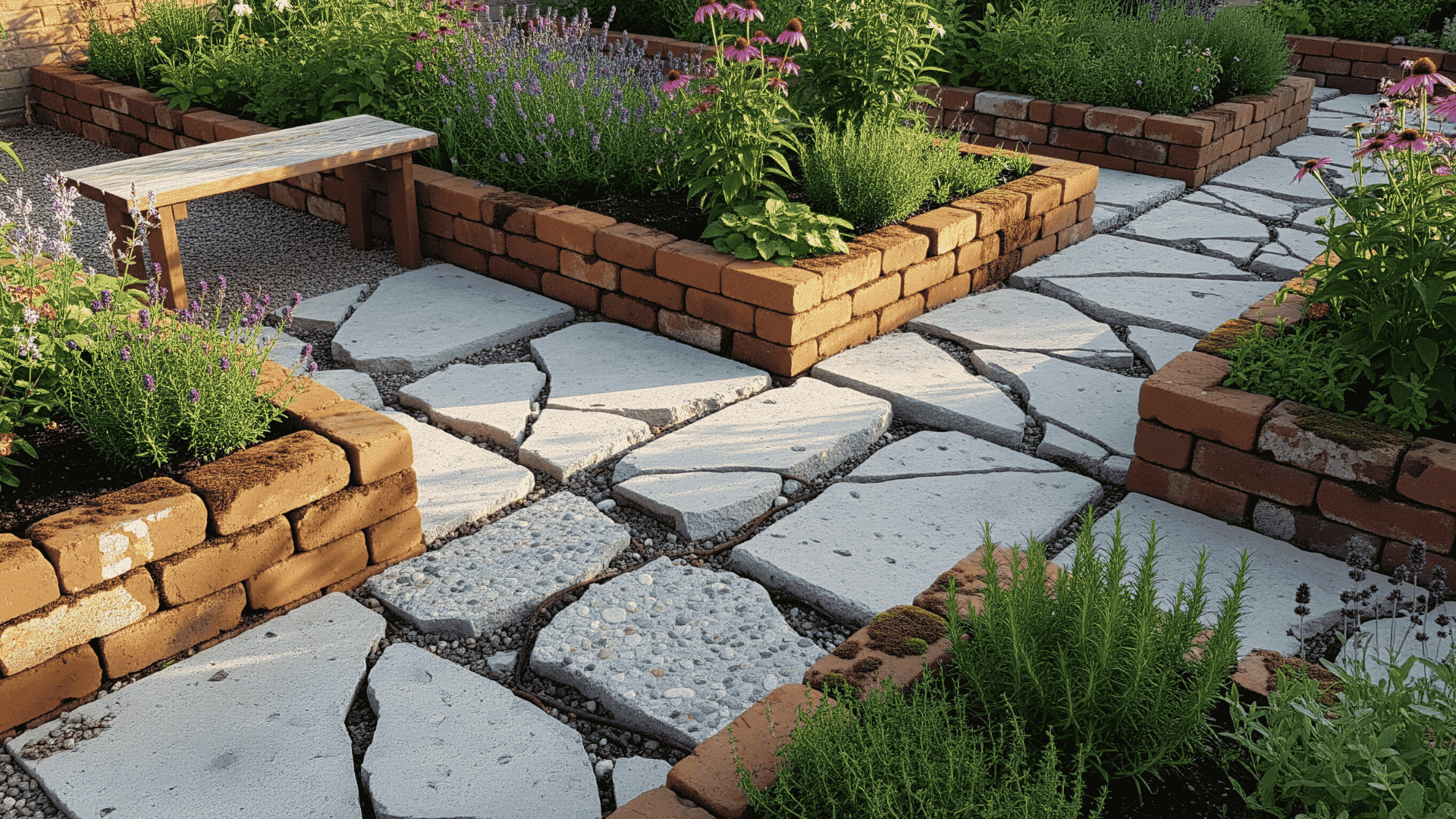
Reusing old bricks or broken concrete is a clever way to build garden paths, edging, or raised beds without spending money on new materials.
These items often add rustic character and work well with the raw textures common in desert landscaping. Stack them, embed them in sand, or arrange them freely to define spaces or lead the eye through your garden.
It’s a great method to reduce waste while also creating something useful and attractive. Plus, the weathered look blends beautifully into dry, sun-exposed settings.
- Best for: Walkways, fire pit areas, or raised planter outlines
- Pro tip: Stack them unevenly for a rugged desert vibe
5. Tire Planters for Cactus Displays
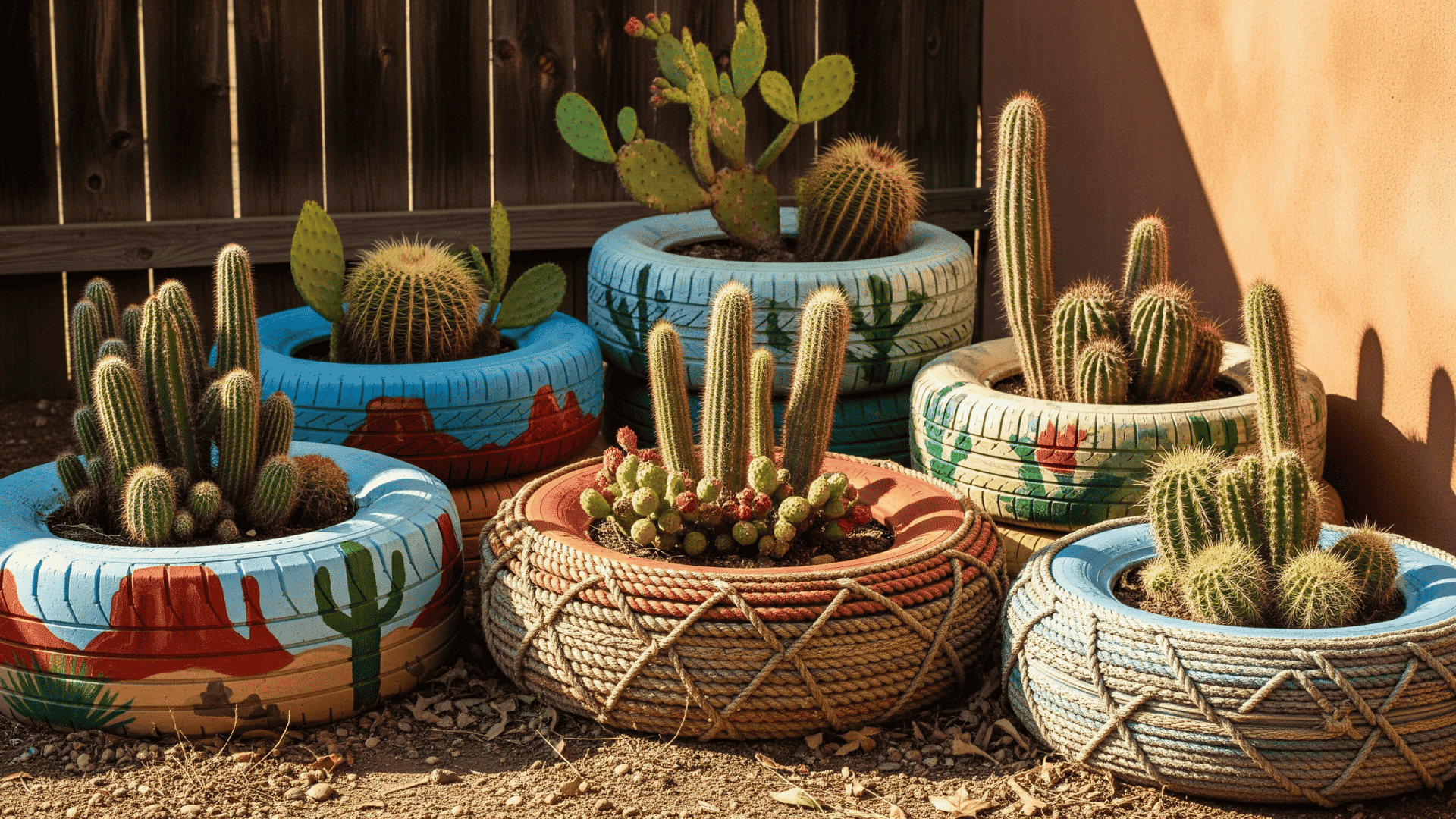
Old tires can be transformed into unique cactus planters at no cost. Simply clean them up, paint them with earth tones, or wrap them in natural rope, and fill them with sandy soil.
Then plant hardy varieties like barrel cacti or agave. These tire planters are durable and provide structure and height in flat areas.
Stack them for added interest or use them as accents in empty corners. It’s a creative way to reuse materials and add a sculptural element to your inexpensive desert landscaping setup.
- Best for: Corners or unused spaces that need height
- Pro tip: Stack two tires for added dimension
6. Native Plants from Cuttings
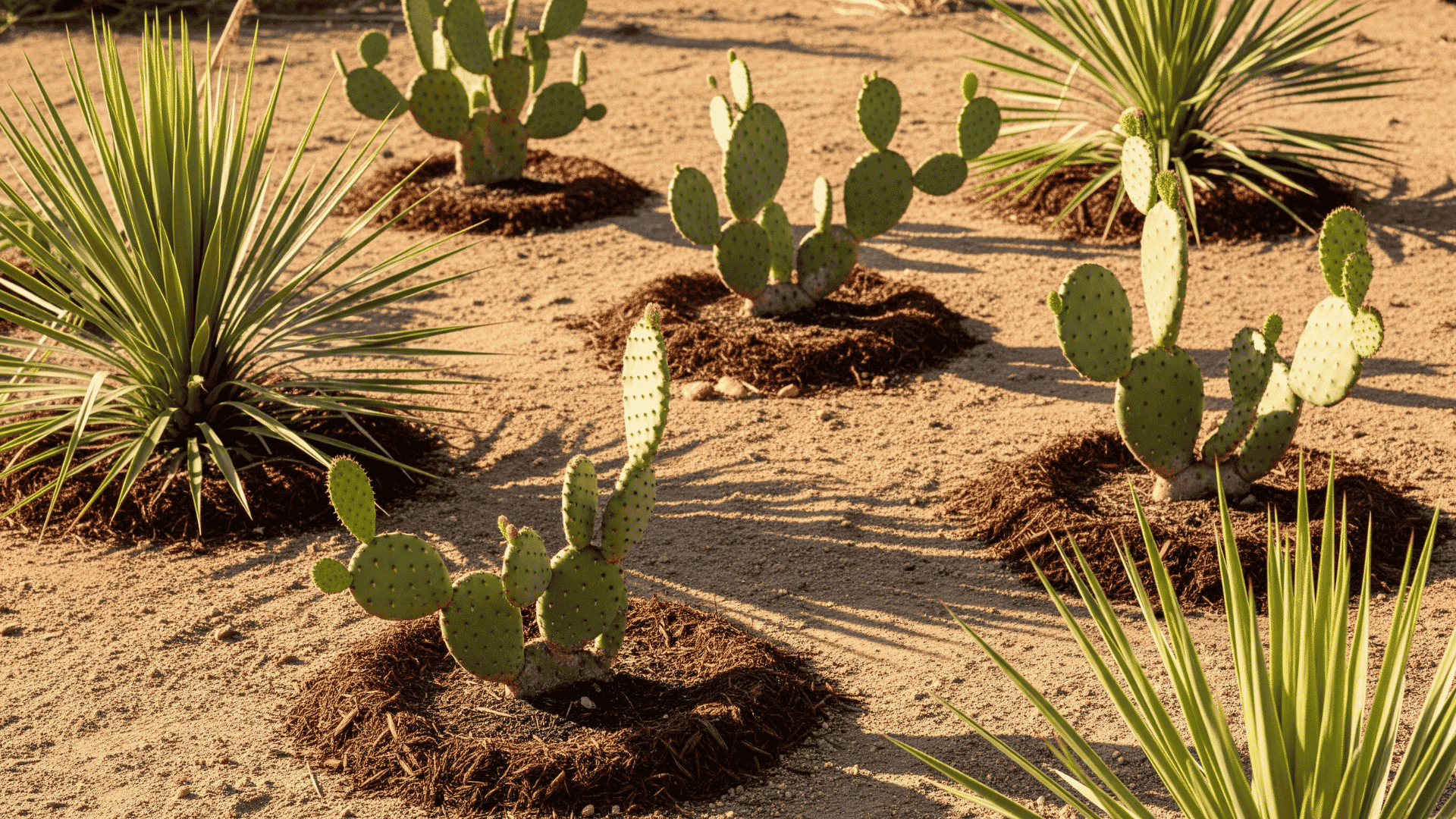
Using cuttings from native desert plants is a smart and affordable way to fill your yard. Many species, like prickly pear or yucca, root easily in sandy soil with very little care.
Ask neighbors or check local plant swaps to collect cuttings for free. These plants are naturally adapted to dry conditions and bring texture and color without needing much water.
Over time, they’ll establish themselves and spread, giving your garden a more natural, cohesive look. This method cuts down both costs and ongoing maintenance needs.
- Best for: Border plantings and filling in bare areas
- Pro tip: Focus on hardy species like prickly pear and yucca
7. Mulch with Rocks
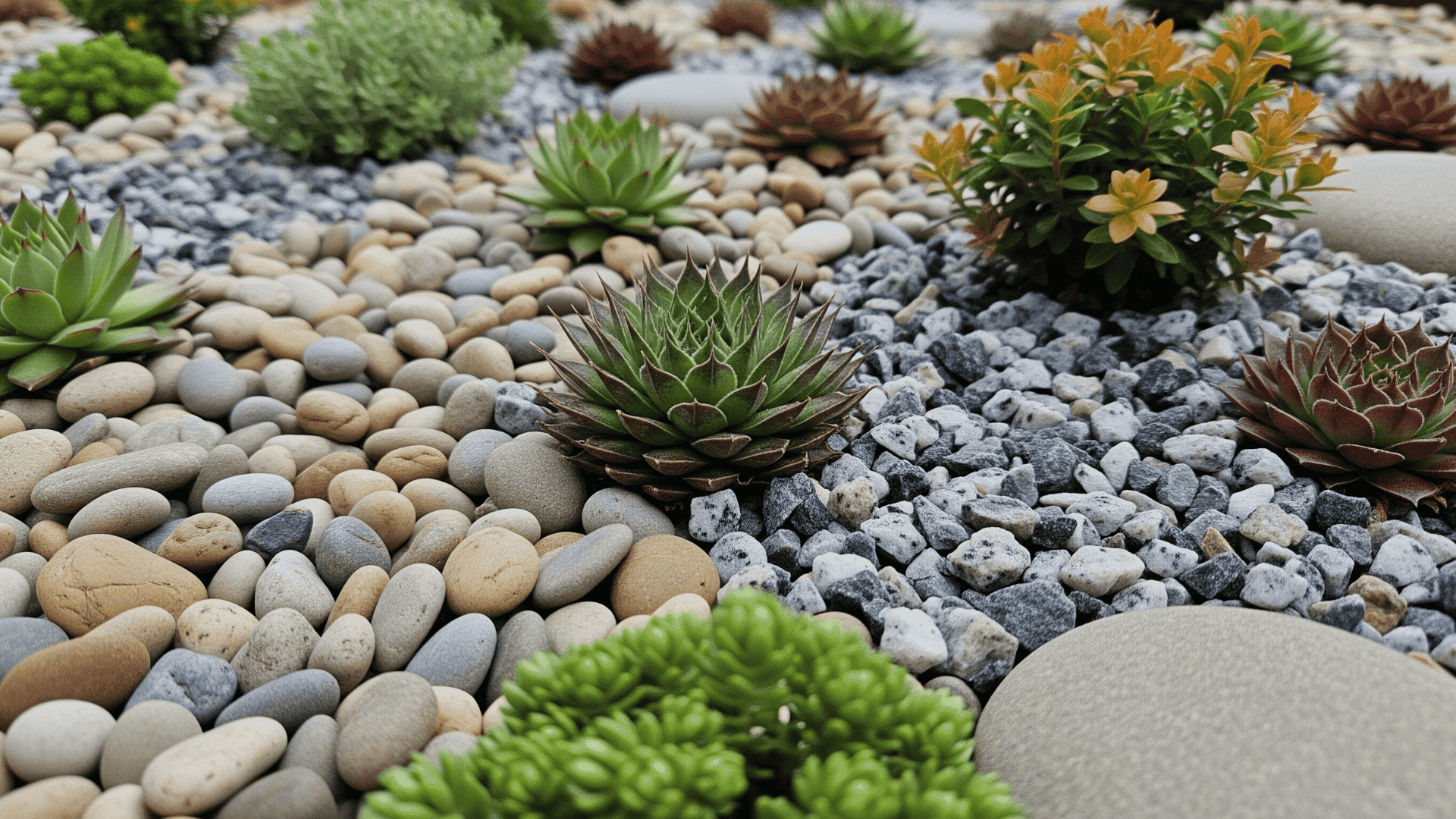
Rocks are an excellent mulch option for desert yards. Instead of bark or synthetic mulch, use pea gravel, crushed granite, or river stones to cover bare soil.
They help hold in moisture, suppress weeds, and reflect heat away from plant roots. Rock mulch also gives your yard a clean, polished look while blending perfectly with desert vibes.
Since rocks don’t break down, you won’t need to replace them often, making it a smart long-term investment for low-cost landscaping with minimal upkeep.
- Best for: Around succulents and walkways
- Pro tip: Mix rock colors for a natural blend
8. Use Pallet Wood for Vertical Gardens
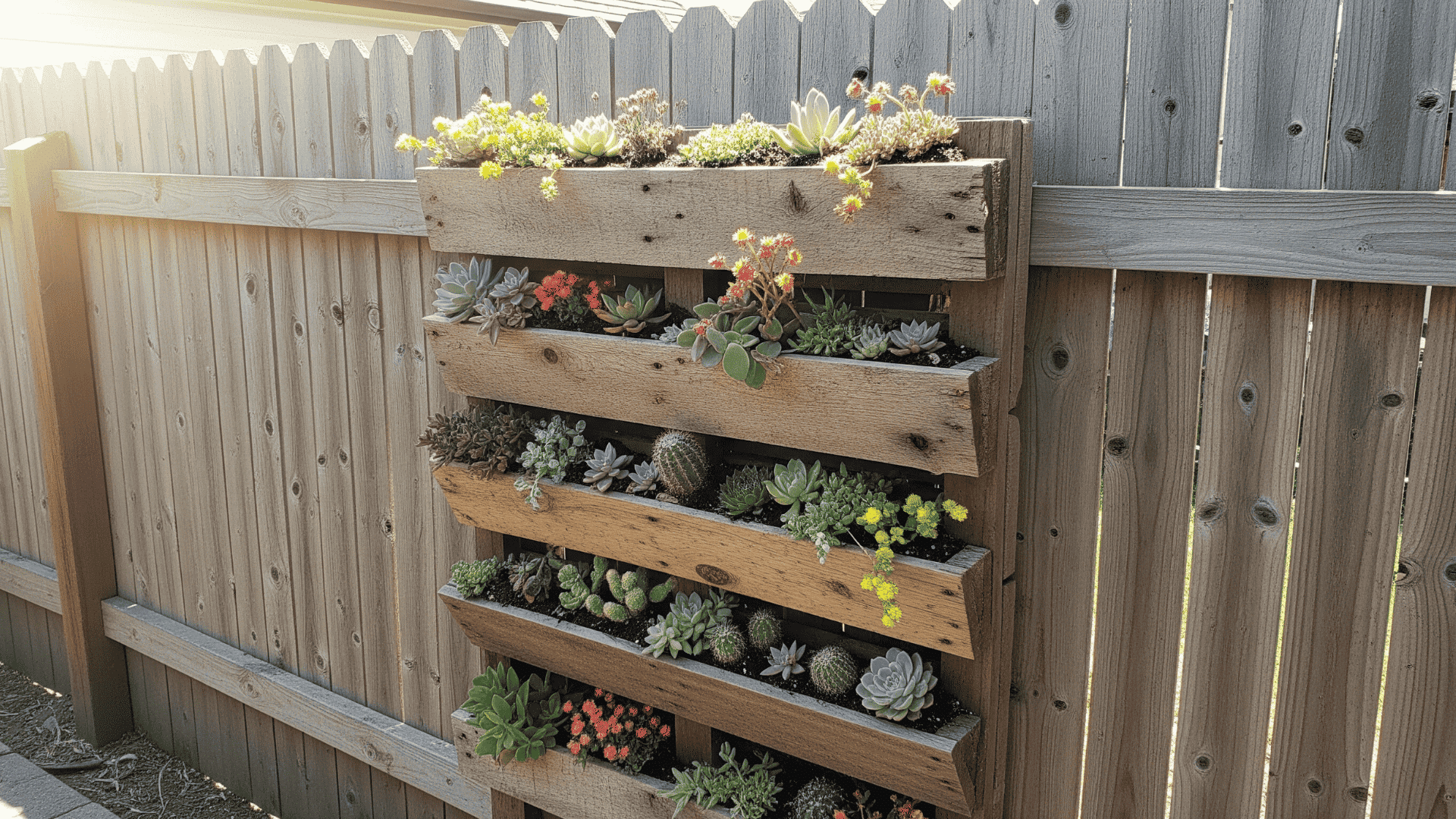
Pallet wood is often available for free and can be repurposed to create vertical gardens in tight spaces. Mount a pallet against a fence or wall, add pockets lined with landscape fabric, and plant small succulents or herbs inside.
This vertical setup adds greenery without taking up ground space and gives a weathered, rustic touch to your yard.
It’s perfect for patios, side yards, or small balconies where horizontal space is limited. Plus, it turns otherwise bare walls into living focal points with very little cost.
- Best for: Small spaces or apartment balconies
- Pro tip: Line the inside with landscape fabric to hold soil
9. Install a Faux Cactus Fence
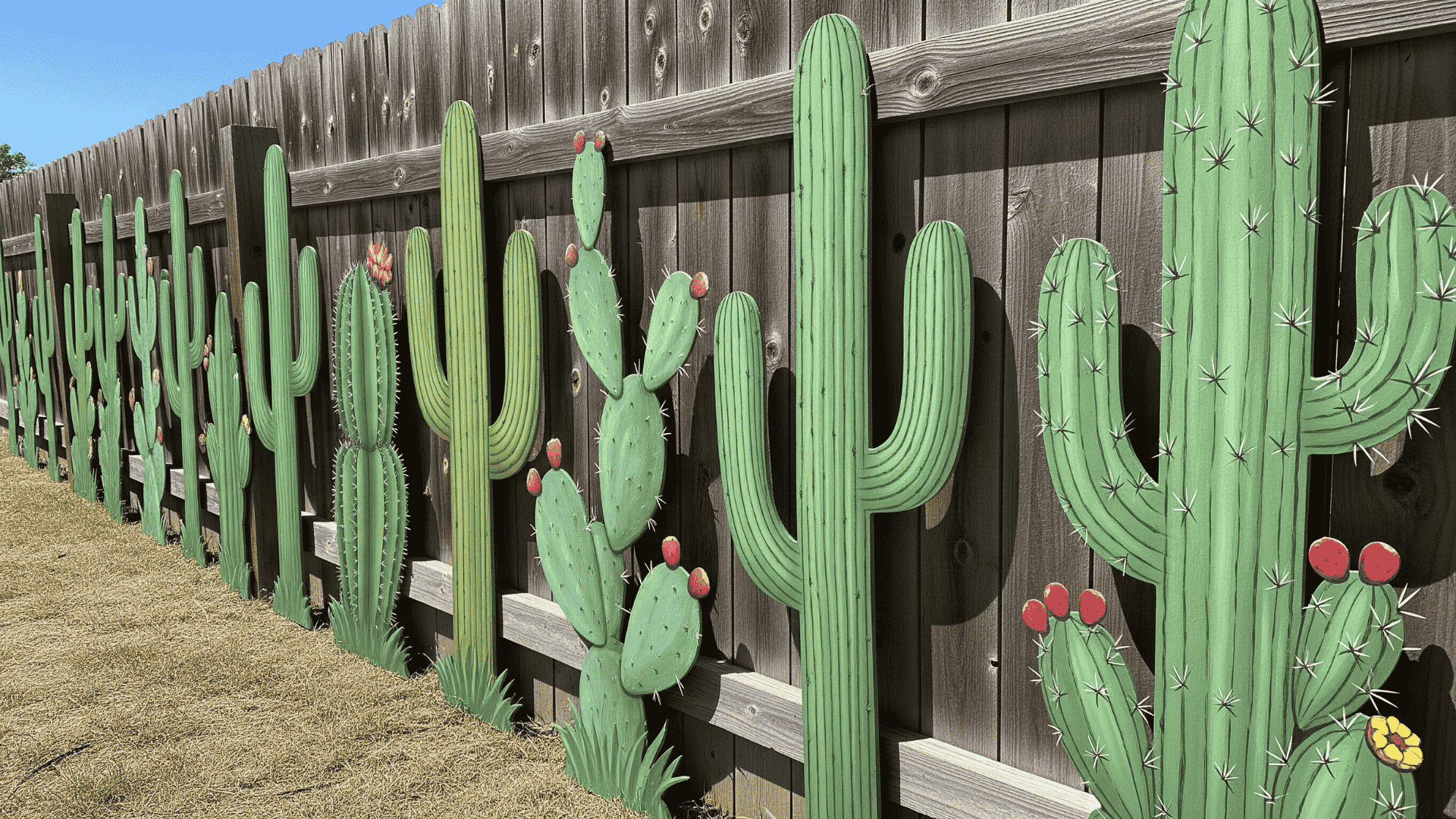
A faux cactus fence adds a playful, creative touch to your desert yard without the upkeep of live plants. Use scrap wood or thin metal sheets to cut out cactus shapes, then paint them in shades of green.
Line them along your fence or garden edge to create a quirky visual border. This is an excellent option if you want height, color, and character without buying or planting anything.
It works well in kids’ areas and gives your space a fun, handcrafted desert vibe.
- Best for: Kids’ play areas or playful front yard borders
- Pro tip: Add solar lights to highlight them at night
10. Bottle Tree Art
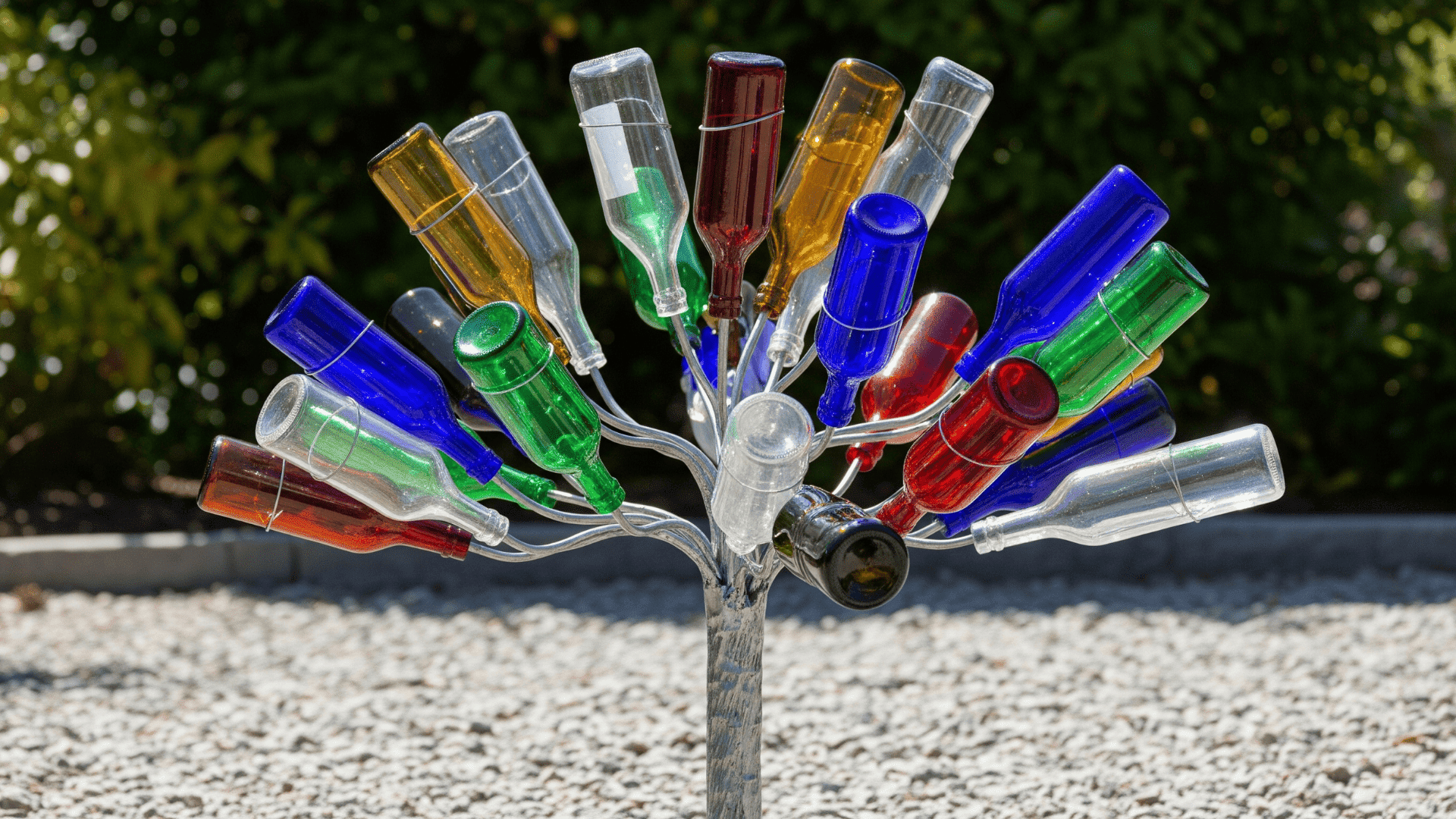
Bottle trees are colorful and whimsical garden features made by placing painted glass bottles on upright metal or wood branches.
They reflect sunlight beautifully and offer a touch of art among plants and rocks. This idea costs almost nothing if you reuse bottles and scrap materials.
It’s a Southern desert favorite that brings charisma and personality without adding clutter. Place one in a bare corner to draw attention or use it as a centerpiece surrounded by gravel and succulents.
- Best for: Bare corners or focal spots
- Pro tip: Use different bottle colors for maximum effect
11. Create a Desert Rock Mosaic
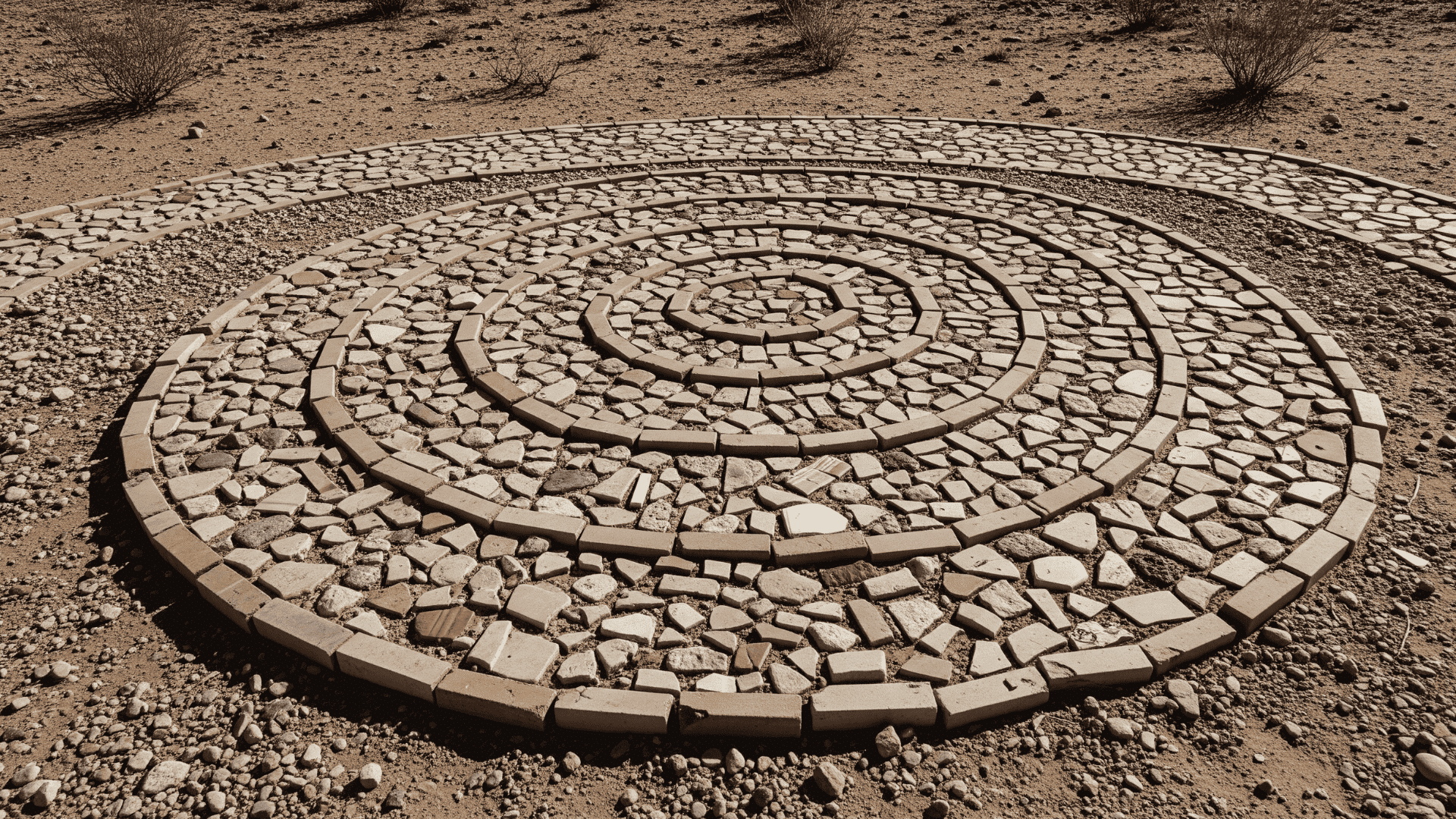
A desert rock mosaic is a creative way to fill space while adding color and pattern. Use leftover pavers, broken tiles, or small stones to build a ground-level design like spirals, waves, or borders.
These mosaics serve as visual anchors for walkways or patio areas, breaking up the gravel.
You don’t need precise cuts; rough shapes give it rustic captivation. This DIY feature adds texture without buying new décor and holds up well in dry climates.
- Best for: Patio centers or pathway landings
- Pro tip: Seal the gaps with sand for durability
12. Use Recycled Furniture as Planters
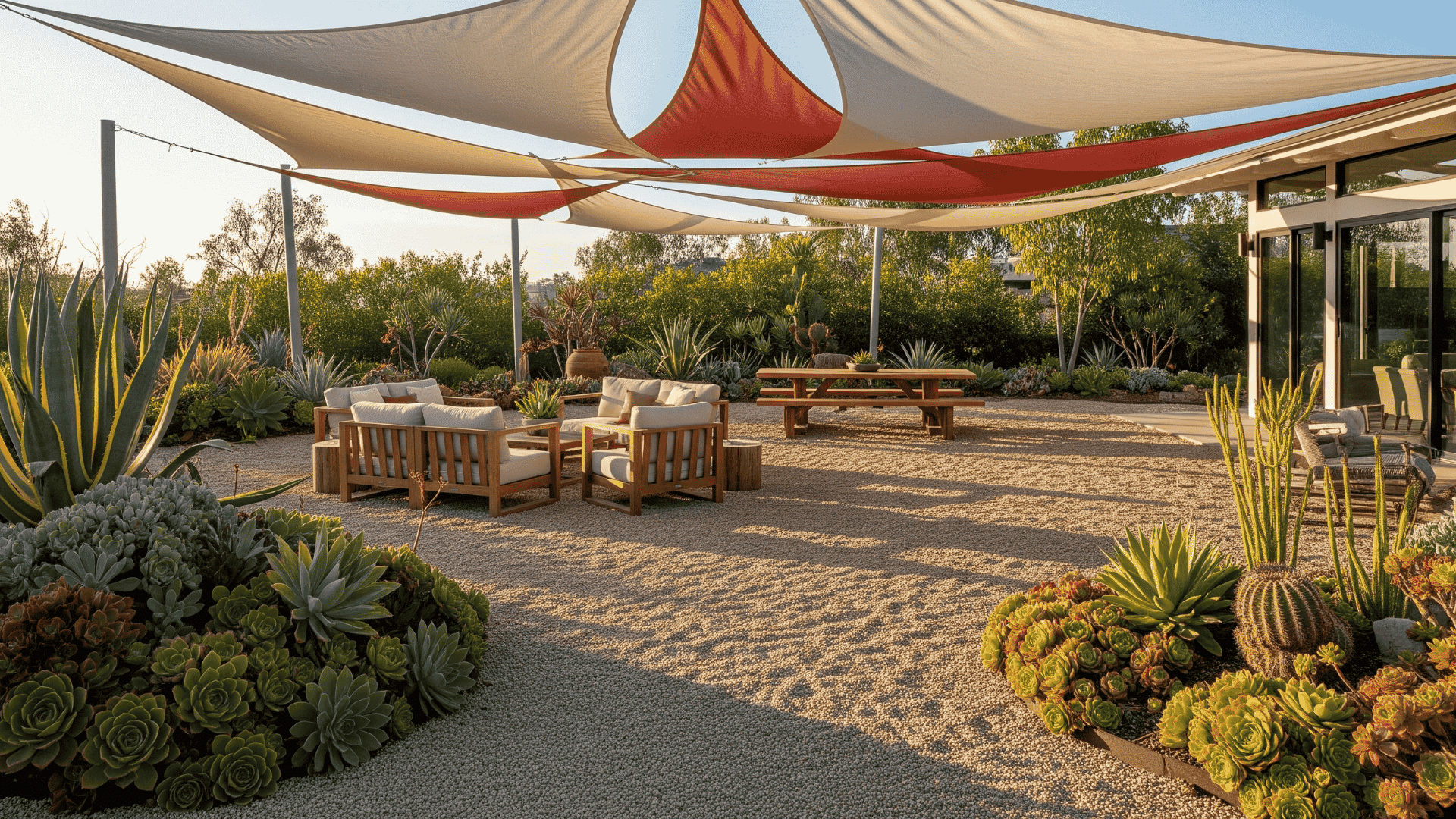
Old drawers, nightstands, or side tables can be turned into quirky planters with a bit of soil and paint. These pieces add charisma and character, especially when grouped with other upcycled items.
Simply line them with plastic or landscape fabric to protect the wood, then fill with hardy desert plants.
This is a fun way to bring indoor style outside, and each piece becomes a talking point in your landscape. It’s also a great reuse option for broken or outdated furniture.
- Best for: Corners, patios, or decks
- Pro tip: Line interiors with plastic to protect wood
13. Hang Shade Sails

Shade sails provide comfort and structure in desert yards without the cost of building a pergola. These triangular or square fabric panels block direct sunlight and define lounging or dining areas.
Install them over patios, gravel seating spots, or near fire pits. They’re budget-friendly, modern-looking, and easy to install using basic hardware.
With neutral or bold colors, they can complement your landscaping and offer relief from the heat while keeping things minimal and open.
- Best for: Sitting areas or patios
- Pro tip: Anchor them to existing walls or posts to save more
14. Broken Pot Landscaping

Instead of tossing out cracked pots, use them as creative planters that look like they’re spilling succulents into your yard.
Partially bury the broken pot on its side, fill it with soil, and then add cascading plants like sedum or small aloe. The result looks intentional and adds a playful touch to your garden beds or borders.
This idea is low-cost, fun to arrange, and turns trash into something artistic. It also adds a sense of flow and movement that fits the desert grace well.
- Best for: Border displays or around stepping stones
- Pro tip: Use larger broken pieces as edging
15. Use Logs or Driftwood
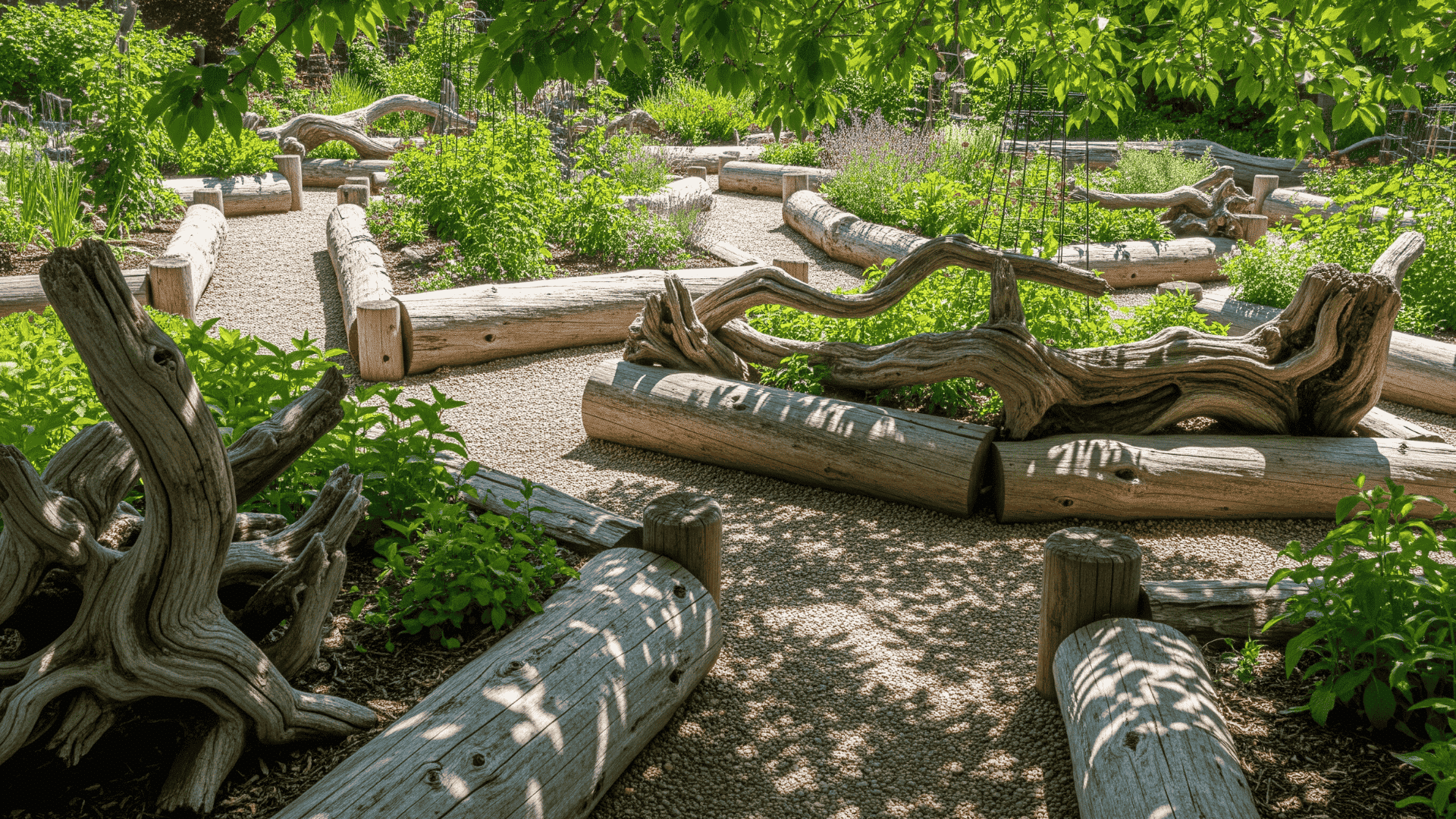
Natural wood elements like fallen logs or driftwood bring warmth and structure to dry landscapes. Arrange them as borders, rustic seating, or sculptural accents between rocks and plants.
The weathered textures pair well with succulents and gravel, giving your space a raw, grounded feel. Logs can define garden zones or serve as planting frames when hollowed slightly.
Look for salvaged wood from local cleanups or nearby trails to keep the cost at zero. It’s a great way to add character without overdecorating.
- Best for: Large open spaces that need grounding
- Pro tip: Treat wood to prevent decay if placed directly on soil
16. Stack Flat Stones for Planters
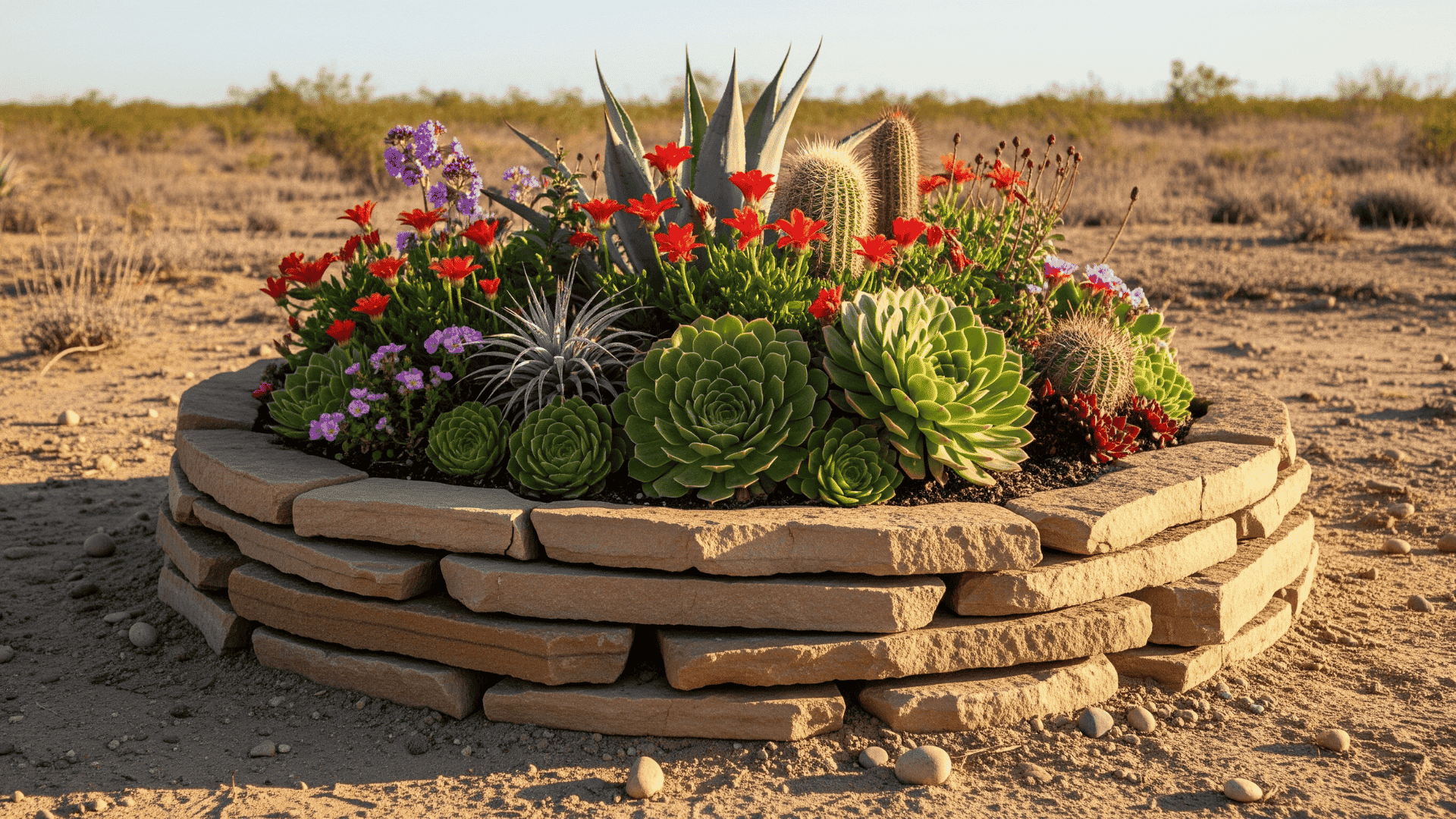
Flat stones can be stacked into small rings to create natural-looking raised planters. This DIY technique adds layers to your desert yard and helps contain soil around plants like yucca, aloe, or desert marigold.
You can collect stones locally and arrange them in a loose circle or square, depending on your layout. These stone beds are free if you source them yourself, and they blend in well with arid landscapes.
Use them to break up gravel areas or as accents near pathways.
- Best for: Grouping succulents or herbs
- Pro tip: Place larger stones at the bottom for structure
17. Create a Mini Sand Garden
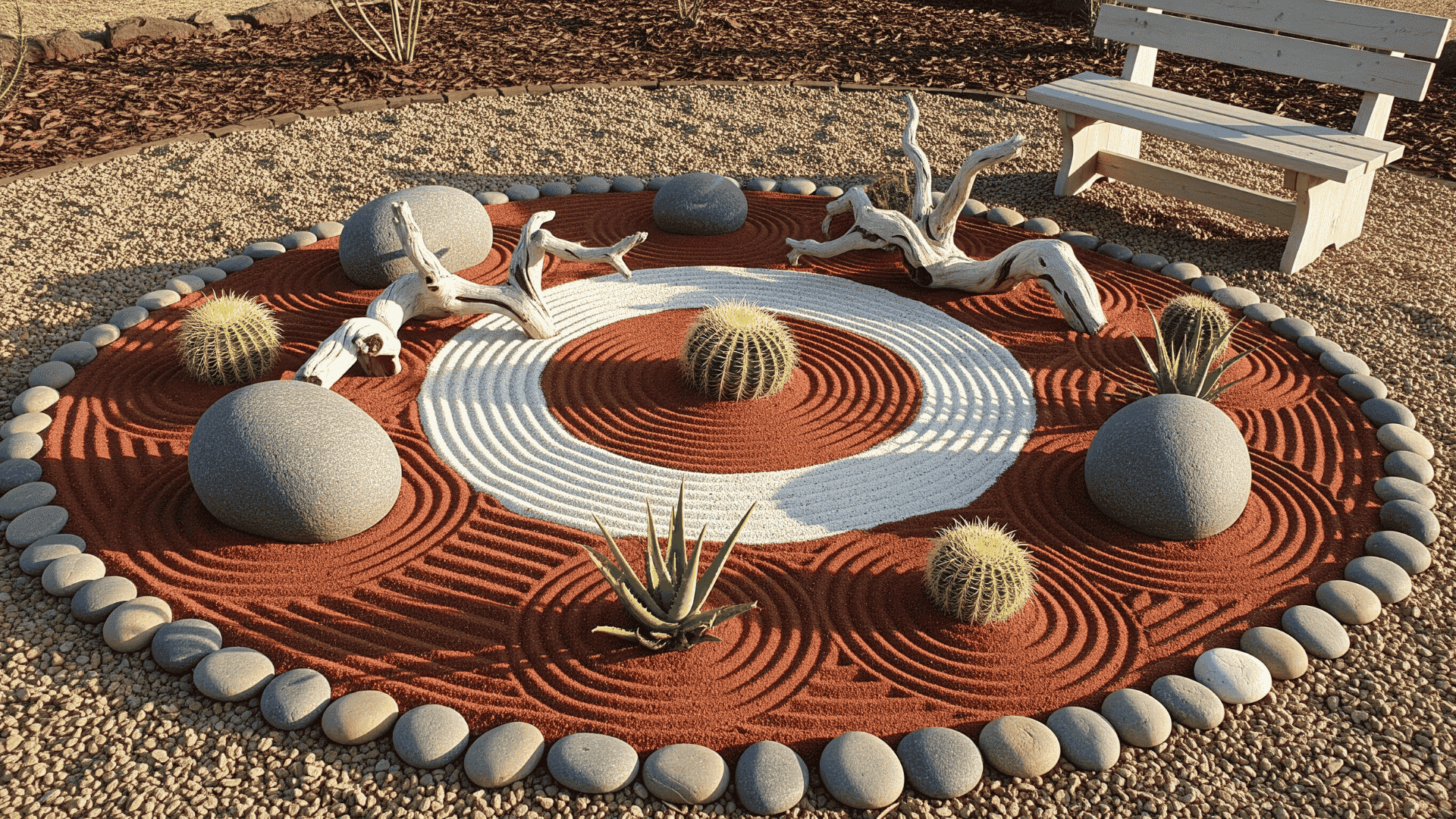
A mini sand garden gives your space a peaceful corner that’s simple, budget-friendly, and reflective of desert style. Choose red or white sand, then rake it into patterns around large stones, driftwood, or cacti.
This idea works well in small yards or courtyards and is easy to maintain. It’s also a great solution for areas that don’t support plant growth.
Add stepping stones or a bench nearby to make it feel like a calming retreat.
- Best for: Entryways or meditative corners
- Pro tip: Rake the sand regularly to refresh the design
18. Use Salvaged Metal as Garden Art

Scrap metal can become bold garden art when placed thoughtfully in a desert setting. Old gears, rods, or panels add structure and contrast against natural elements like rocks and succulents.
You can leave the metal bare for a weathered, rustic look or paint it for a touch of color. Use it as fencing, sculpture, or even planter borders.
This approach adds visual depth without much cost and gives your space an industrial edge that fits the rugged desert vibe.
- Best for: Accent pieces among rocks
- Pro tip: Paint them for contrast or leave them to rust naturally
19. Paint Rocks with Desert Themes
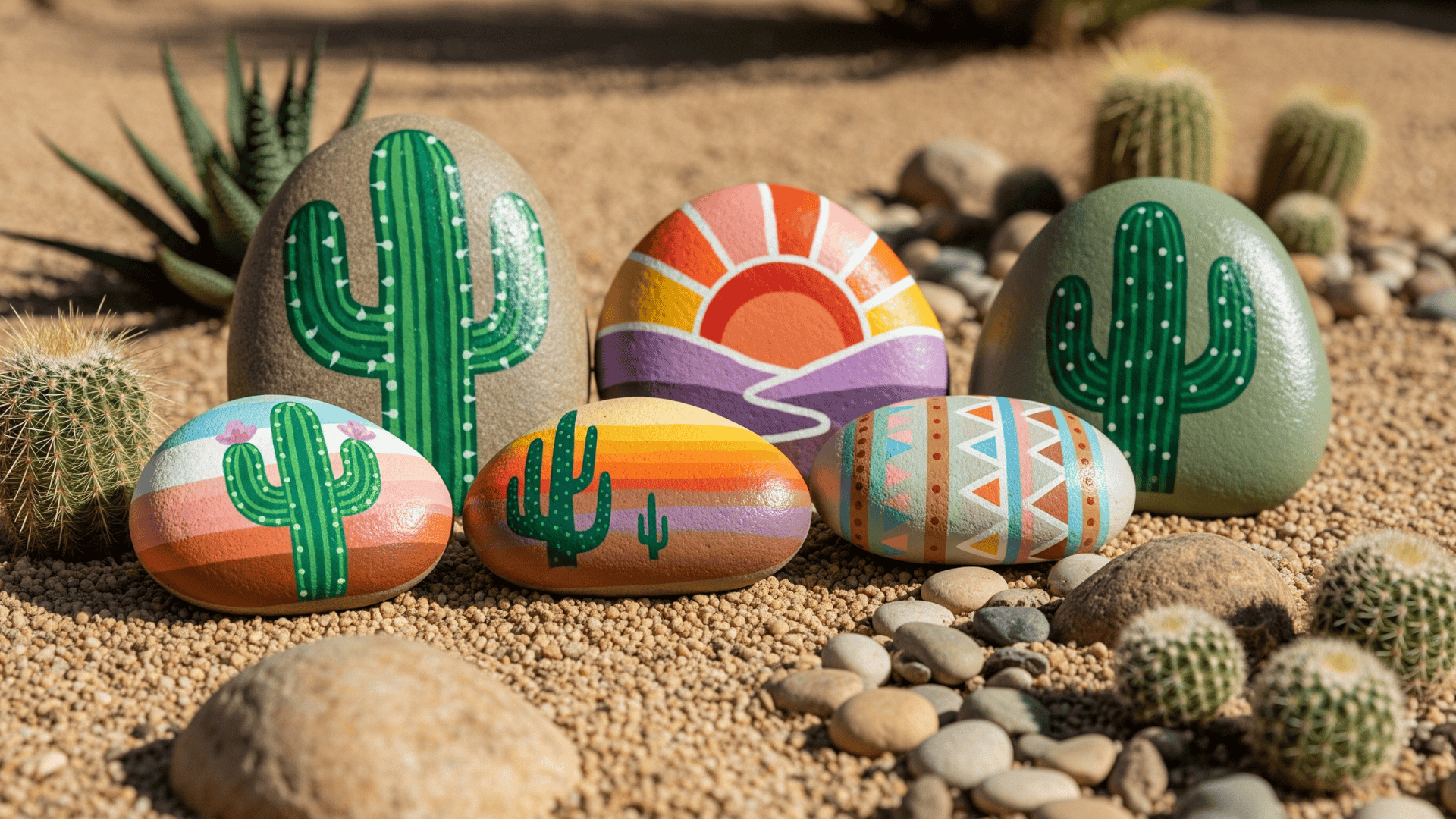
Smooth river rocks or landscaping stones can be painted with desert-themed designs like cacti, sunsets, or geometric shapes.
Place them throughout your yard to add color and a personal touch. It’s a fun project for kids or guests and costs almost nothing if you already have paint and brushes.
Painted rocks help fill in empty areas and can be used to mark pathways, borders, or garden zones. They also make great conversation starters and add magnetism to simple layouts.
- Best for: Adding fun to otherwise plain areas
- Pro tip: Seal with outdoor paint to prevent fading
20. Add Stepping Stones
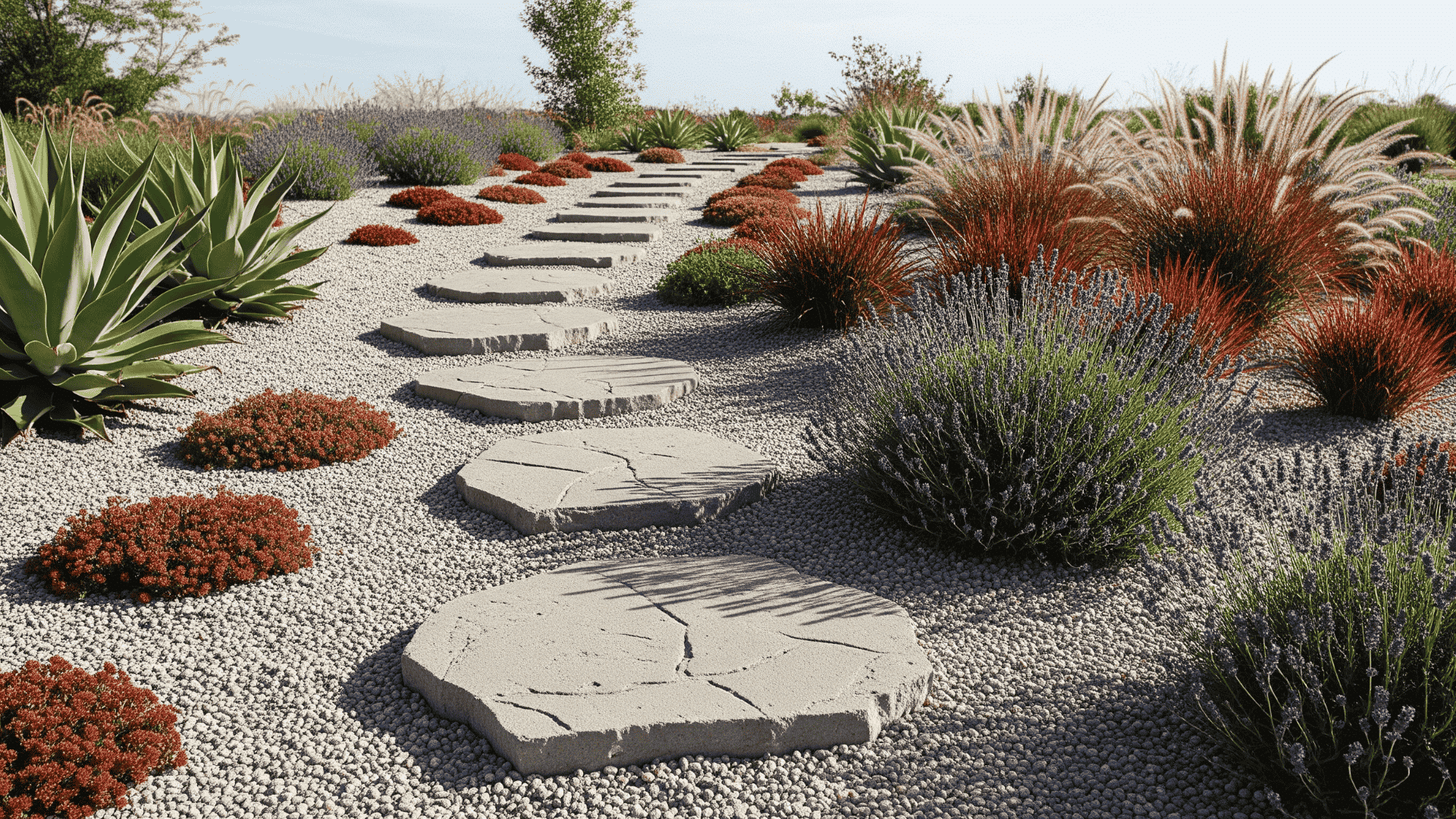
Stepping stones are functional and decorative, helping you define paths through gravel, sand, or rock gardens. Use affordable concrete molds or repurpose flat stones to lay a walkway.
They guide foot traffic while adding rhythm to your design. Stepping stones are especially useful in larger yards where gravel alone can feel monotonous. Mix shapes and spacing to keep it relaxed and natural-looking.
This low-cost addition brings both structure and charisma without disrupting the desert look.
- Best for: Directing foot traffic in the yard
- Pro tip: Alternate stone shapes for an organic feel
21. Turn an Old Wheelbarrow into a Planter
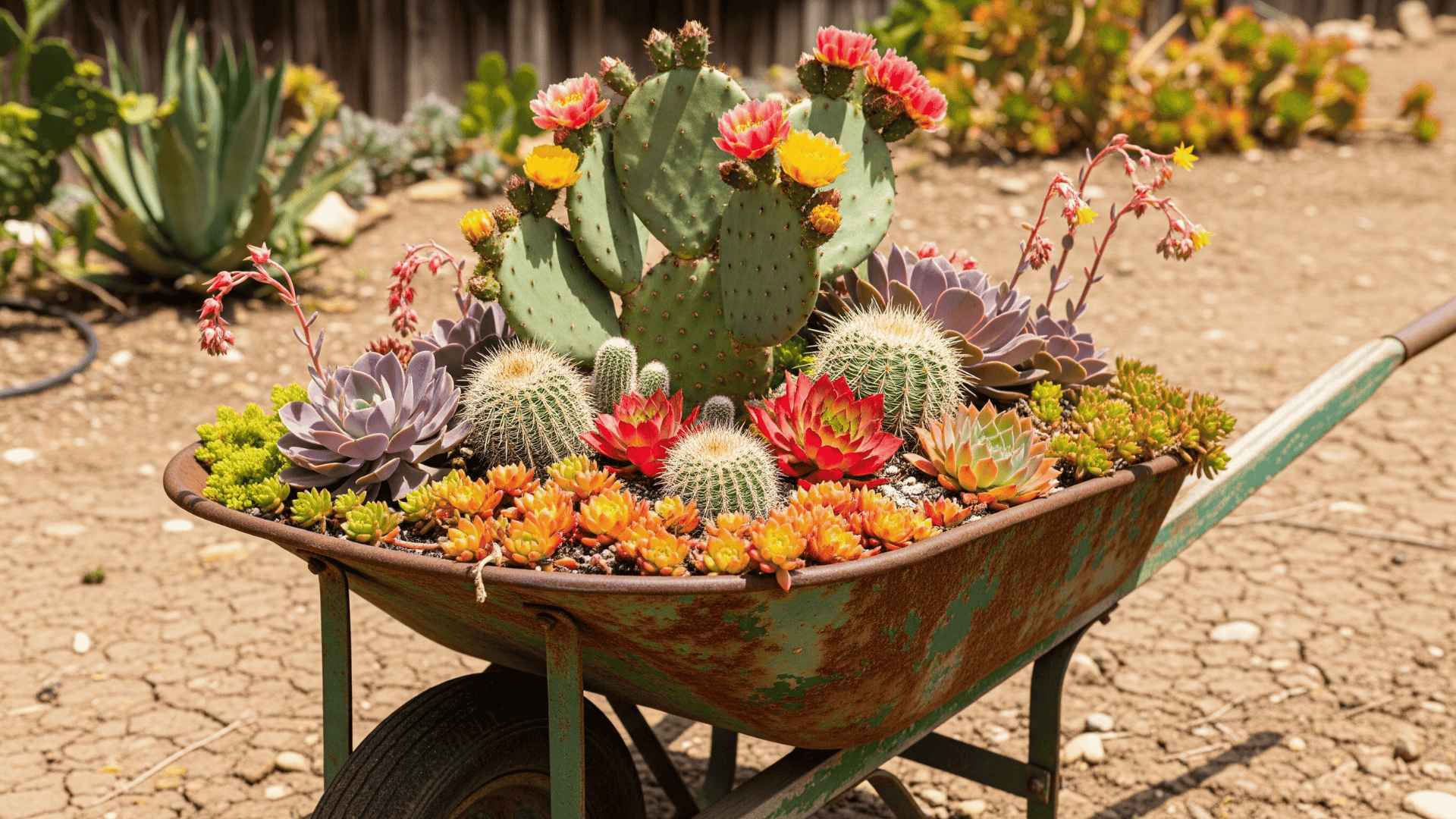
An old wheelbarrow can become a standout planter that fits right into your desert layout. Just fill it with cactus soil and plant it with hardy succulents, herbs, or flowering desert plants.
You can tilt it slightly so the plants look like they’re spilling out, or keep it level for a tidy appearance. It’s easy to move if needed and adds a touch of character to patios or open spaces.
Plus, it gives new life to something you might otherwise discard.
- Best for: Centerpieces or movable displays
- Pro tip: Tilt it slightly for a cascading plant effect
22. Paint Old Pots
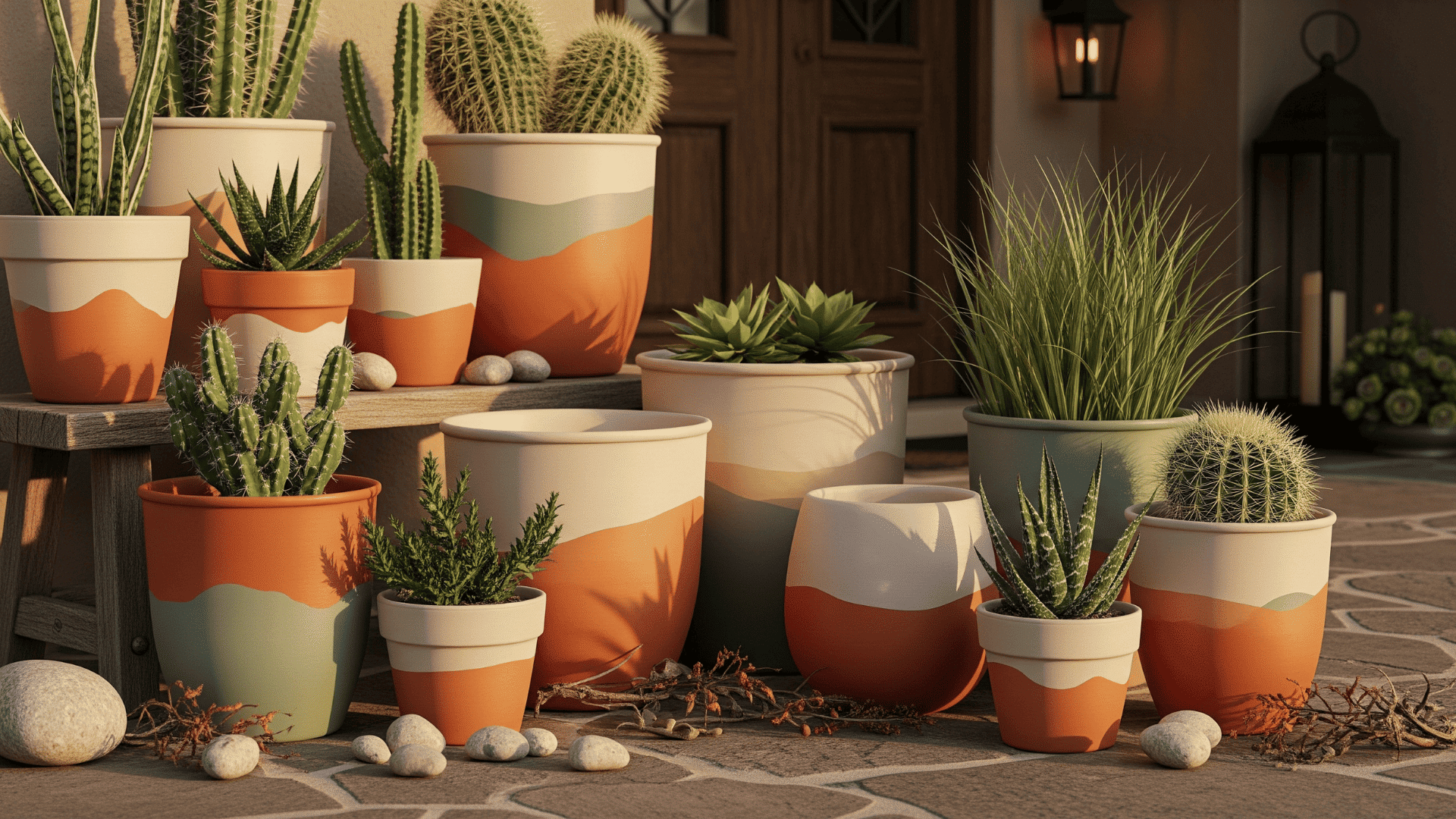
Old terracotta or ceramic pots can be refreshed with spray paint to create vibrant accents in your desert yard. Choose warm desert tones or bold colors to contrast with gravel and succulents.
Painting gives older pots new life and helps unify mismatched containers. Cluster them in groups of different heights for visual depth. This is an easy way to add interest without buying new décor.
It also allows you to coordinate your color palette without much effort or cost.
- Best for: Porch or patio corners
- Pro tip: Use chalk paint for a weathered matte look
23. Use a Rope to Hang Planters

Hanging planters with basic rope or macrame is a cost-effective way to add height and variety to desert landscaping. Suspend small pots filled with succulents or trailing plants along fences, walls, or pergola posts.
This method frees up ground space and adds movement to vertical areas. Use recycled rope or twine for a natural look that fits dry landscapes.
Hanging planters also help keep plants out of reach of pests and can turn dull corners into attractive focal points.
- Best for: Walls, fences, and narrow side yards
- Pro tip: Mix pot sizes and types for a relaxed look
24. Concrete Block Seating

Cinder blocks can be stacked into simple outdoor seating that’s sturdy, functional, and fits with desert design. Arrange blocks in a bench shape, add a wooden seat or outdoor cushion, and place it near a fire pit or gathering space.
This type of seating is highly durable and blends well with gravel, stone, and sand. It’s also movable and easy to update with a coat of paint or different cushions.
It works great in backyards where casual seating is needed on a budget.
- Best for: Fire pit areas or patios
- Pro tip: Paint blocks to match the surrounding tones
25. Repurpose Garden Tools
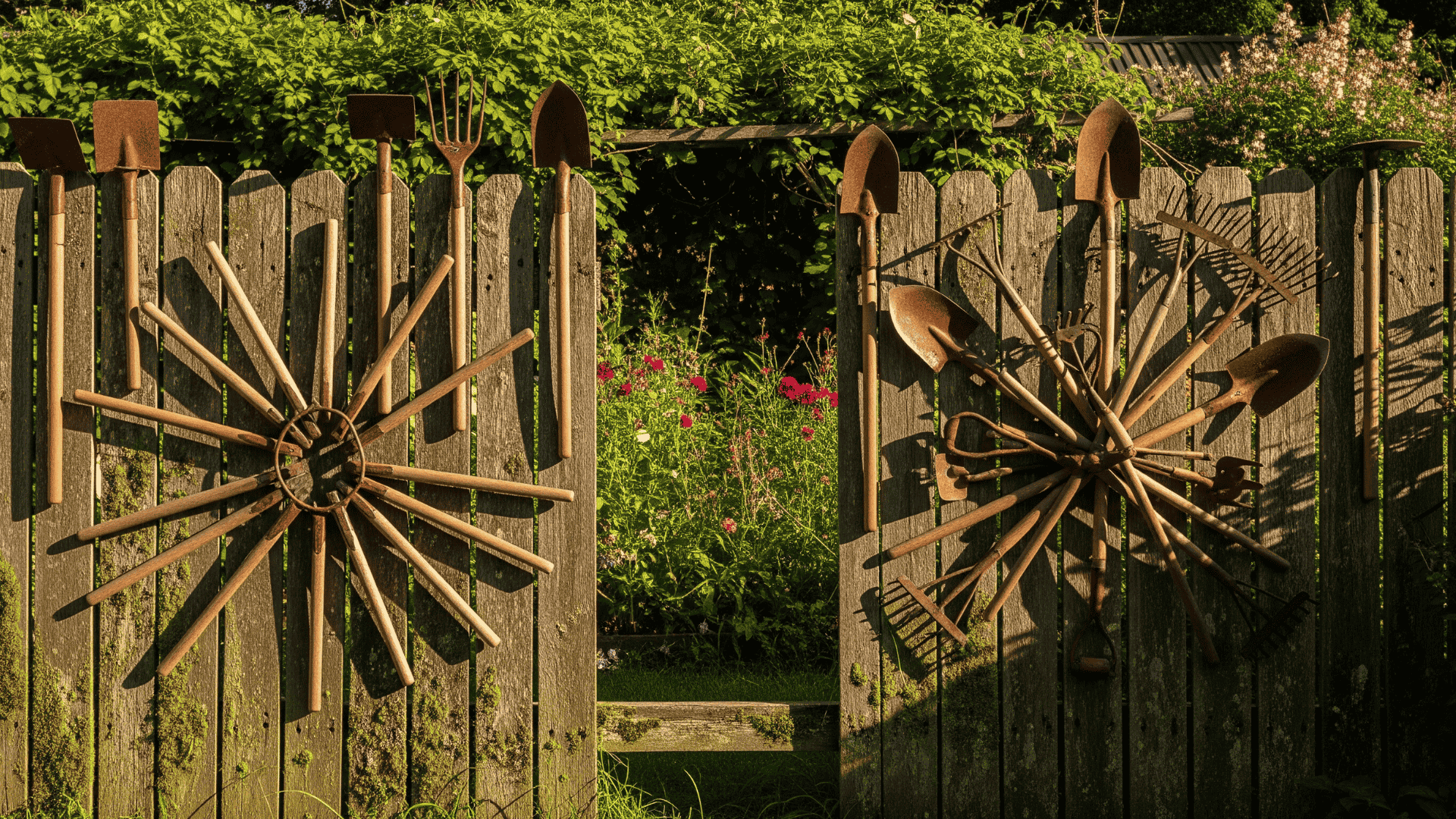
Old garden tools like shovels, hoes, and rakes can be turned into creative yard art. Paint or group them into themed arrangements along fences, sheds, or garden beds.
These tools add a rustic, handmade lure and help fill empty vertical space with something visually engaging. You can even weld them into shapes or spell out words.
It’s a fun way to reuse worn-out items while adding a personal element to your space. Plus, they look great in any weathered outdoor setting.
- Best for: Fence art or backdrop displays
- Pro tip: Weld tools together to form themed garden stakes
26. Plant in Repurposed Cans
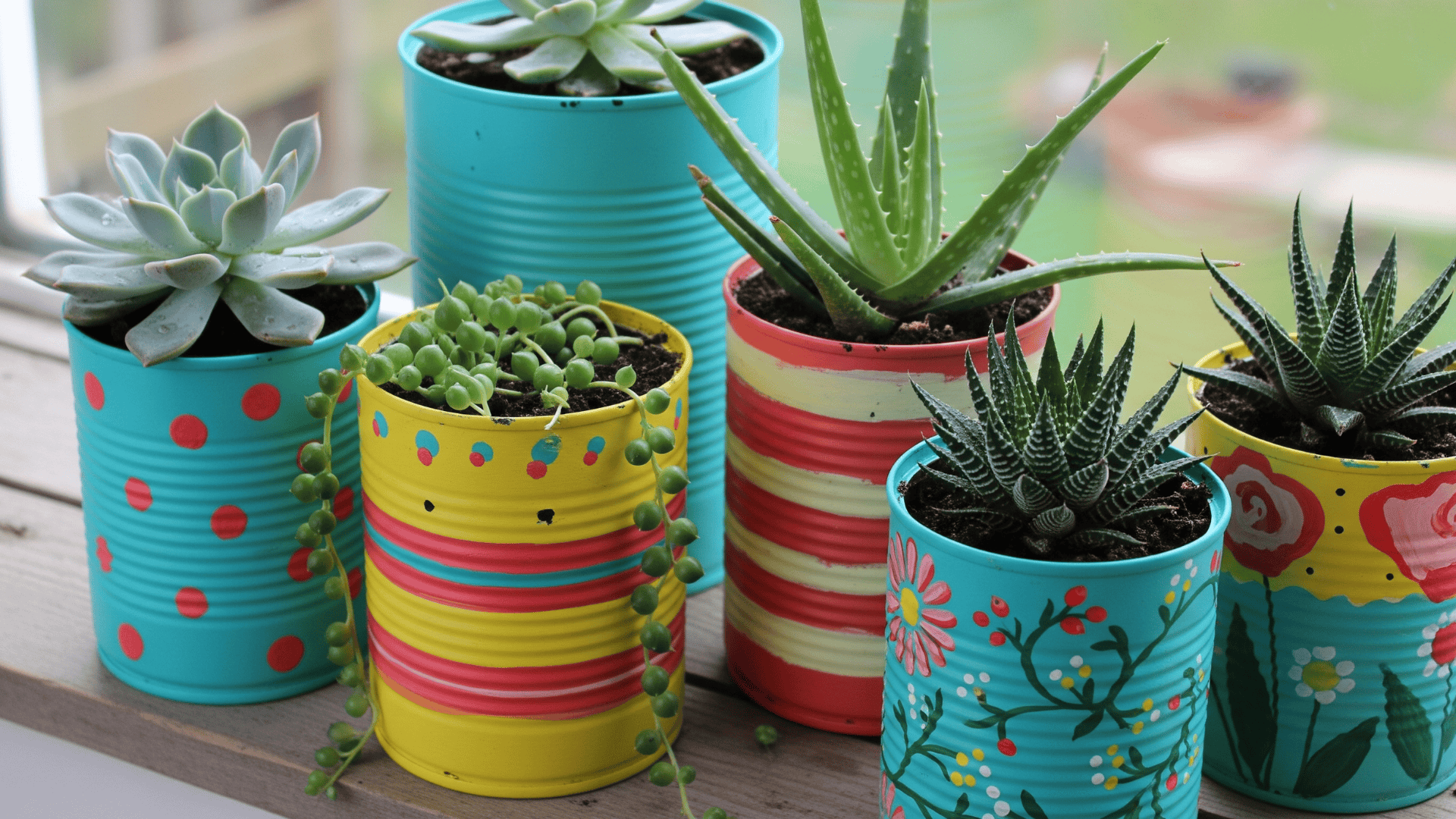
Metal food cans make perfect mini planters for succulents and cacti. Clean them out, punch a few drainage holes in the bottom, and paint them or leave them bare for a rustic look.
These small containers are great for patios, windowsills, or hanging on fences. Their compact size makes them easy to rearrange, and they’re especially useful for small desert plants that don’t need much soil.
This idea gives your outdoor space a handmade feel without spending a dime on containers.
- Best for: Window sills or small patio tables
- Pro tip: Drill drainage holes before planting
27. Use Bamboo or Reed Screens
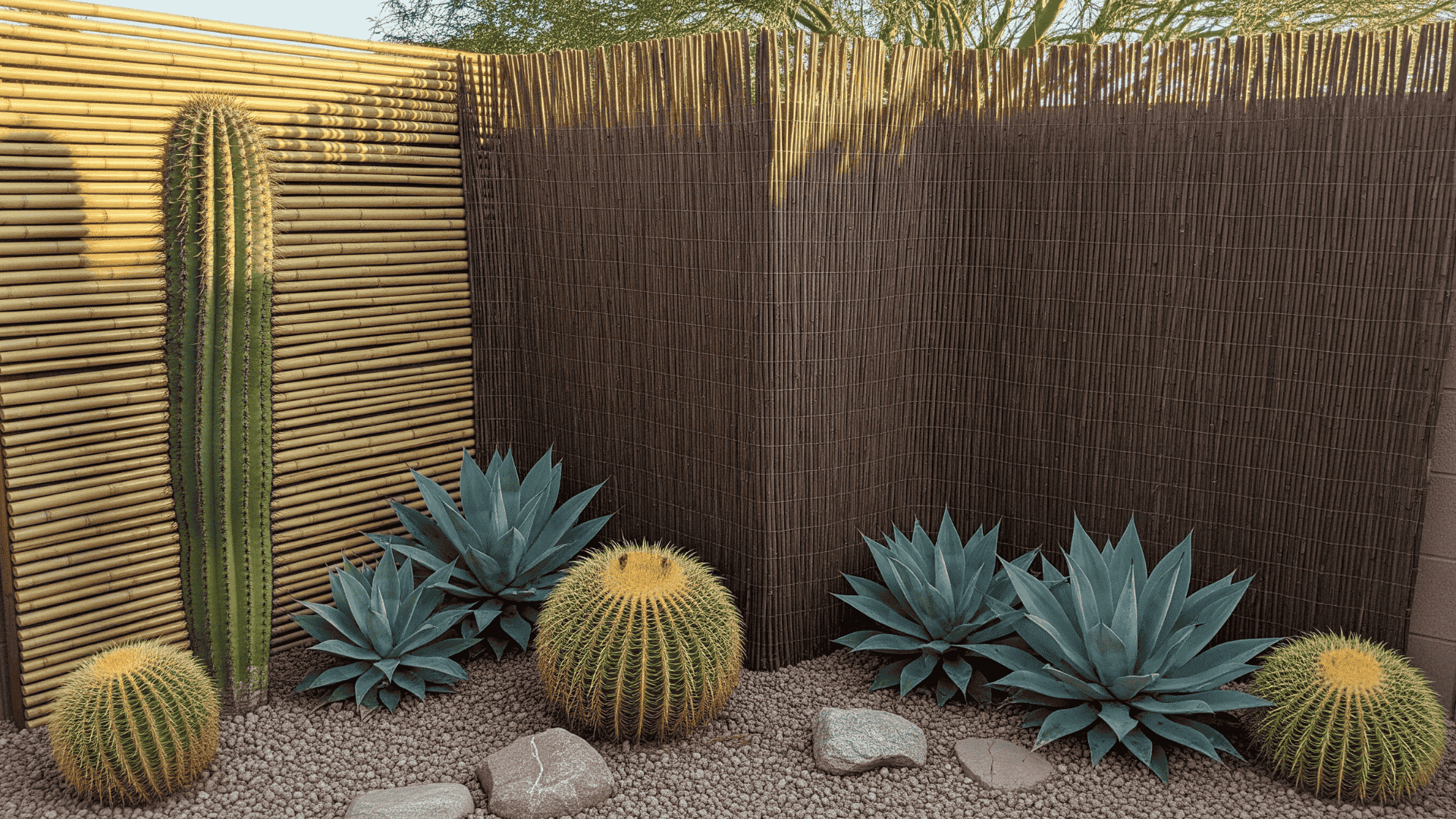
Bamboo or reed screens offer a quick and affordable way to add privacy and definition to your yard. These screens can block views of utility areas or neighbors while blending beautifully into a desert setting.
Lightweight and easy to install, they can be mounted along fences, walls, or pergolas. Their natural texture pairs well with succulents, gravel, and sand.
They also provide partial shade without enclosing your space, making your yard feel more private and structured without major construction.
- Best for: Screening off unsightly areas
- Pro tip: Add lights or vines
28. Add Solar Lights
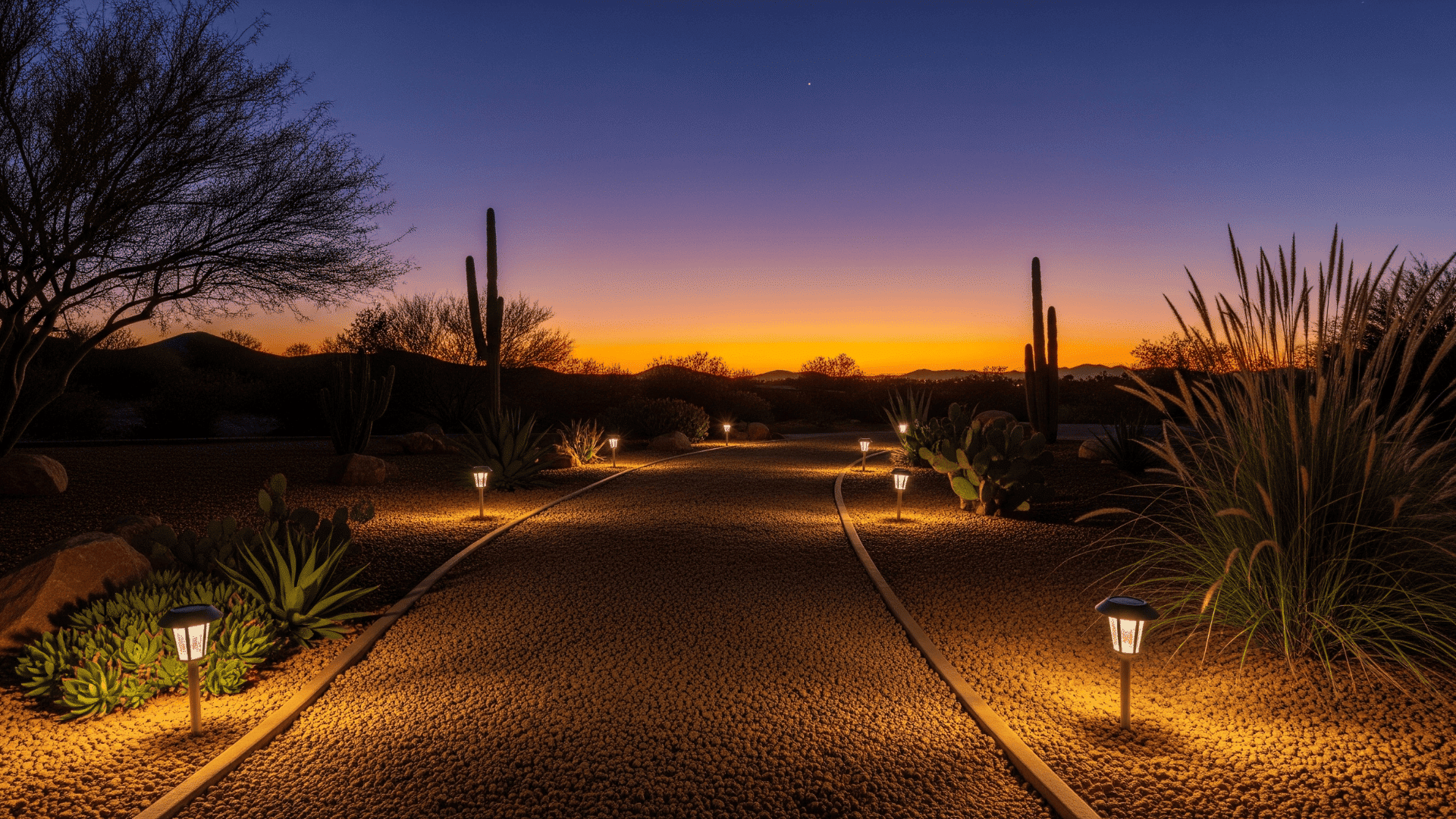
Solar-powered lights are a simple way to illuminate your desert landscape at night without increasing your utility bill. Stick them along walkways, riverbeds, or near feature areas like planters or benches.
They charge throughout the day and provide soft lighting in the evening, adding warmth and visibility.
Choose warm-toned LEDs for a cozy glow that enhances the colors and textures of your rocks and plants. Since they don’t need wiring, you can move them around easily to highlight new areas anytime.
- Best for: Evening pathways and border highlights
- Pro tip: Choose warm-toned LEDs for a softer glow
29. Paint a Desert Mural
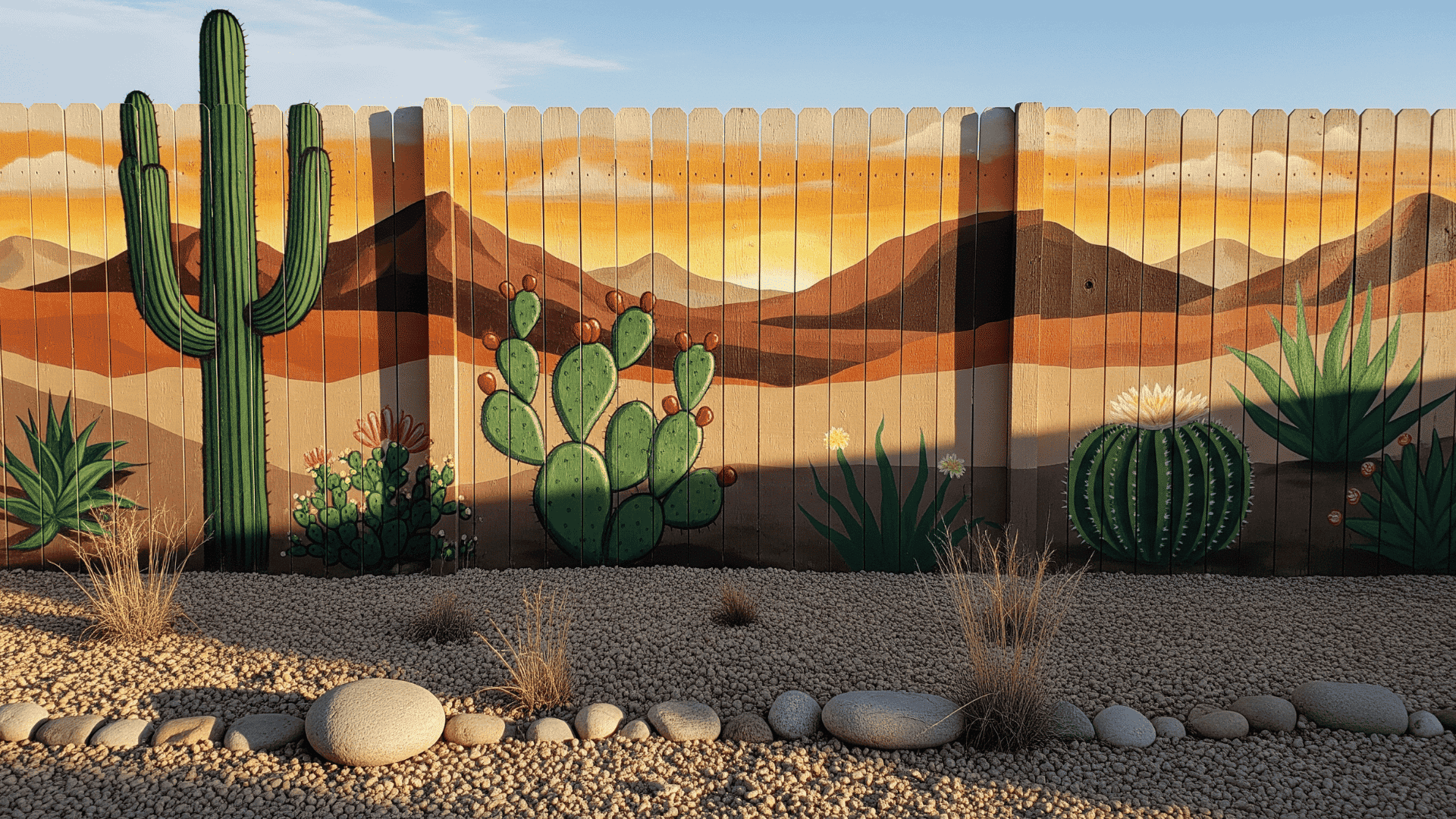
Painting a simple mural on a wall or fence can completely change the feel of your yard. Use exterior paint to create cactus shapes, desert hills, or sunset scenes for a backdrop that adds depth and interest.
Even a basic design can make a plain fence feel like a feature. This works especially well in small yards where you don’t have room for large plants or décor.
It’s affordable, long-lasting, and a great way to express personality without cluttering your layout.
- Best for: Blank walls that feel too plain
- Pro tip: Outline with chalk before committing
30. Use Mirrors Outdoors

Mirrors can create the illusion of more space in small desert yards. Place an old mirror on a fence or wall to reflect light and nearby plants.
This makes the area feel brighter and more open, especially in narrow or enclosed spots. You can frame it with salvaged wood, stones, or metal to match the natural desert look.
Mirrors are especially effective near seating areas or tucked into shaded corners. Just be sure to angle them safely to avoid harsh reflections or heat buildup.
- Best for: Enclosed patios or small gardens
- Pro tip: Hang at an angle to reflect the sky
31. Make a Cactus Rock Garden
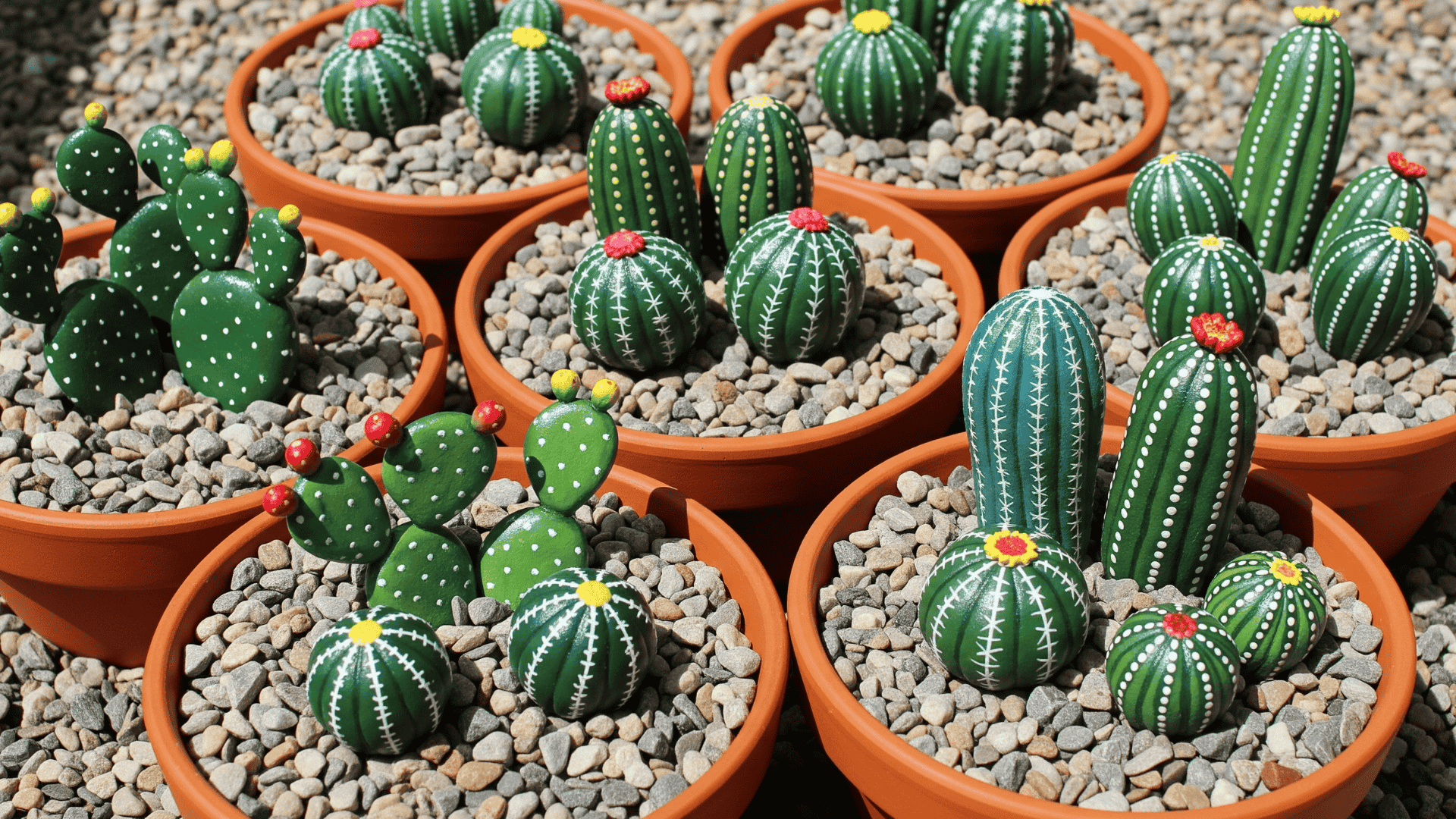
Smooth rocks painted to look like cacti are a fun and long-lasting alternative to real plants. Use green paint in different shades, add white dots for “spines,” and place them in pots or gravel beds.
This is perfect for rental spaces, areas with poor soil, or spots where you want color without maintenance.
These painted stones bring a creative touch and work well for kids’ areas or themed garden zones. Once sealed, they hold up well in any weather.
- Best for: Kids’ areas or rentals
- Pro tip: Mix green shades and dot on “spines”
32. Concrete Slab Fire Pit
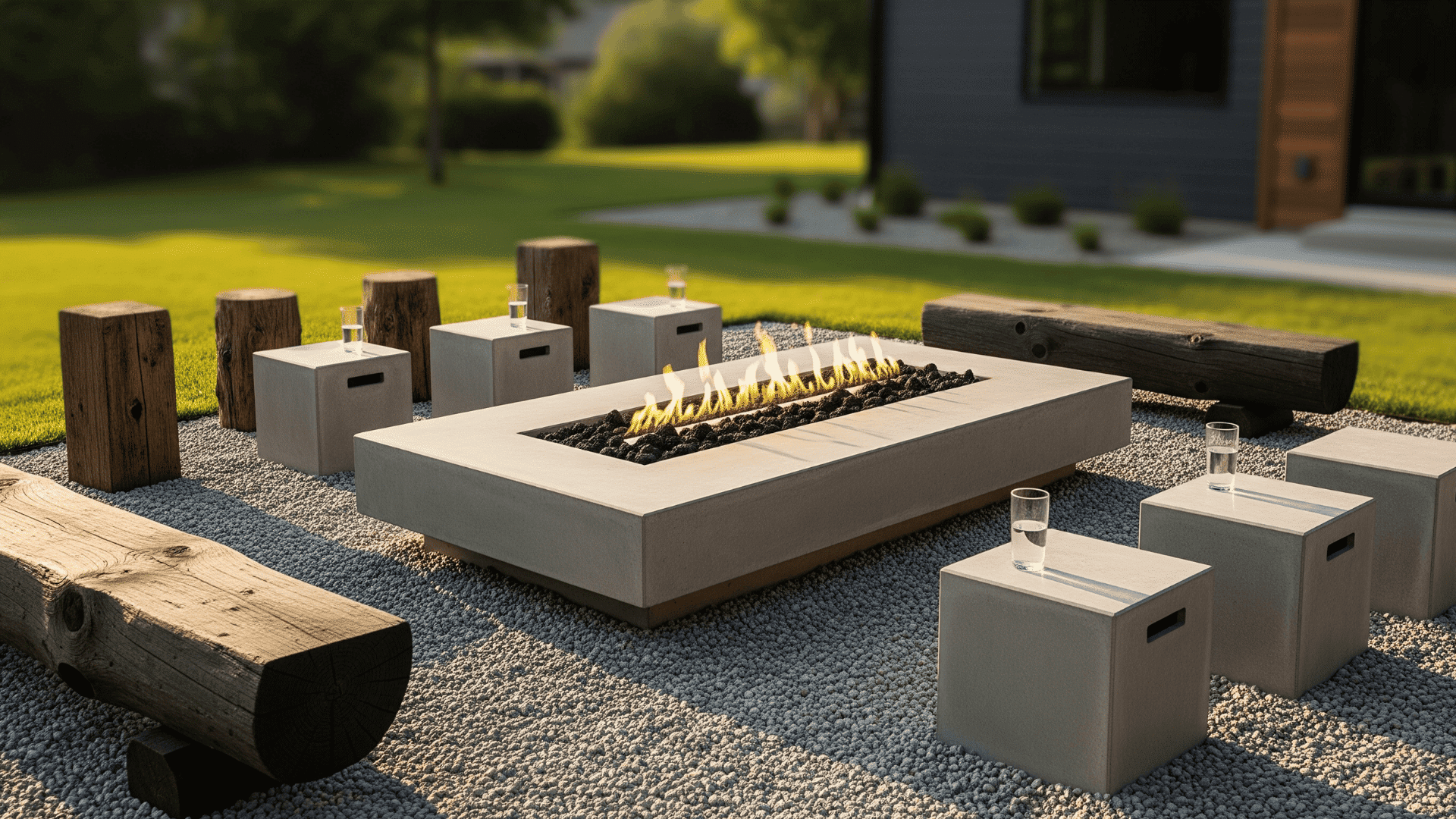
A DIY fire pit made from concrete slabs adds function and warmth to your desert yard. Arrange slabs in a square or circle, and fill the center with gravel or fire-safe material.
It’s a low-cost way to create a gathering spot that blends with desert textures. Surround it with gravel seating areas or simple block benches for a cozy outdoor space.
The clean lines of the concrete pair perfectly with the rugged feel of desert landscapes, making this an inviting focal point.
- Best for: Backyard gatherings
- Pro tip: Surround with gravel for easy cleanup
Tips for Making Your Desert Landscape Look Polished on a Budget
Even with affordable materials and simple ideas, a few thoughtful decisions greatly impact your desert yard’s design. These tips help you create an intentional, balanced, stylish layout without overspending.
- Limit your material and color palette: Stick to a limited palette of materials and colors so everything feels cohesive. Too many textures or tones can make the space look scattered.
- Group plants by type or height: Group plants for a stronger visual impact and easier maintenance. Random placement often feels messy or unfinished.
- Leave intentional open space: Leave open space instead of filling every corner. Desert landscapes shine when there is breathing room between elements.
- Repeat shapes or colors for rhythm: Use repetition in form or color to create rhythm. Repeating the same type of stone or pot across different zones brings balance.
- Layer with height and depth: Mix heights and layers using vertical planters, raised beds, or stacked features to add dimension without extra clutter.
- Soften hard surfaces with texture: Balance hard surfaces with soft textures. Pairing gravel with driftwood or smooth stone with soft ground cover adds warmth and contrast.
Final Thoughts
You don’t need expensive materials or a full renovation to create a great-looking desert yard.
With thoughtful choices and basic supplies, it’s possible to design a space that’s low-maintenance, water-efficient, and attractive.
Many of the best ideas come from working with what you already have: gravel, native plants, reused containers, and salvaged items all play a role.
Desert landscaping is about balance, texture, and simplicity, not high costs.
Even if you’re starting fresh or adding to an existing space, these ideas can help you create a landscape that feels natural, welcoming, and easy to maintain for years to come.
If you found these ideas helpful or know someone planning a desert yard makeover, feel free to share this post.


